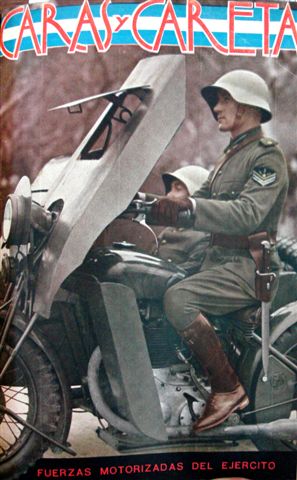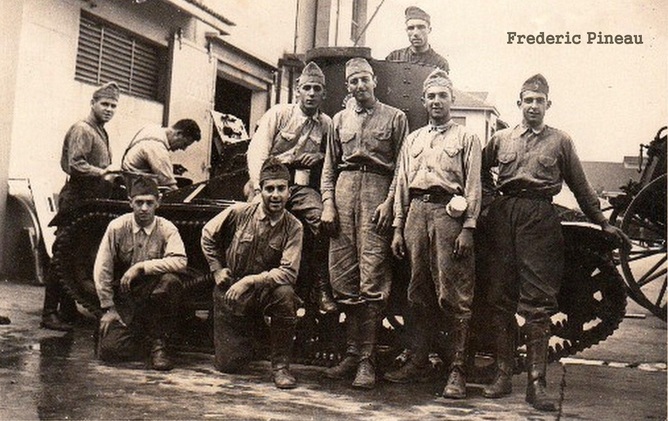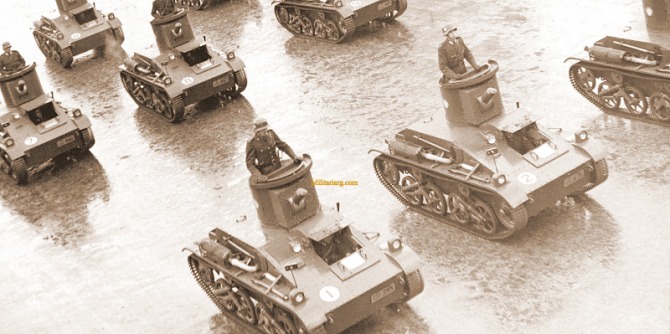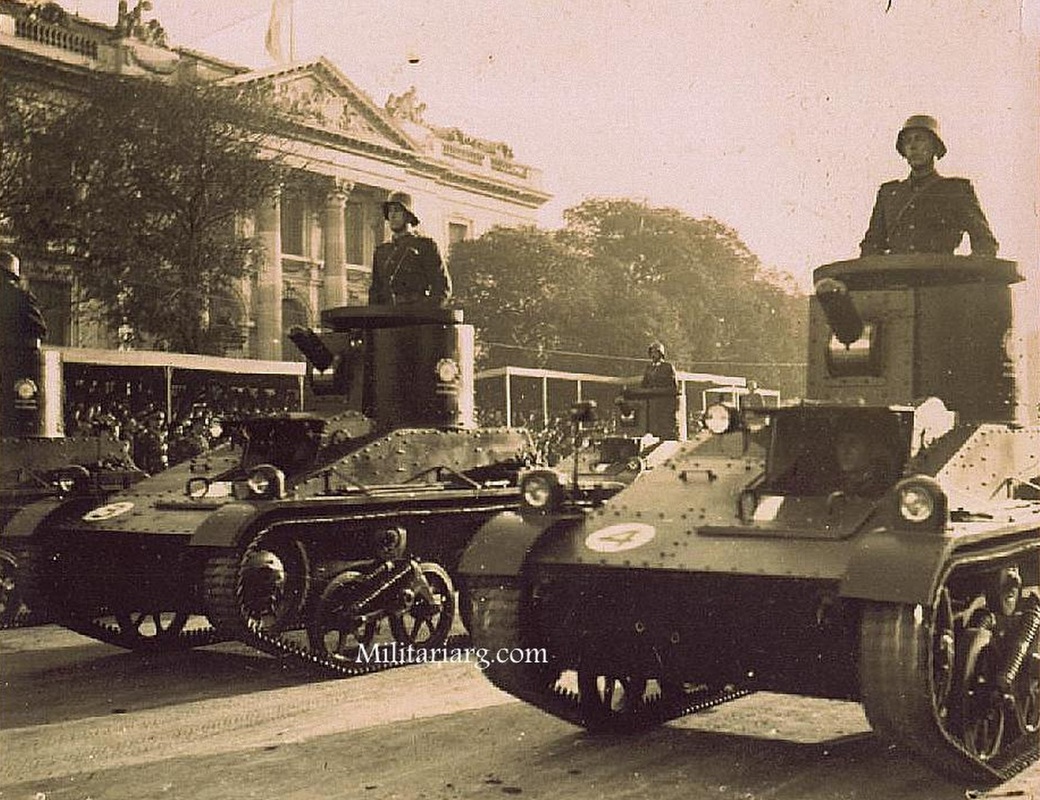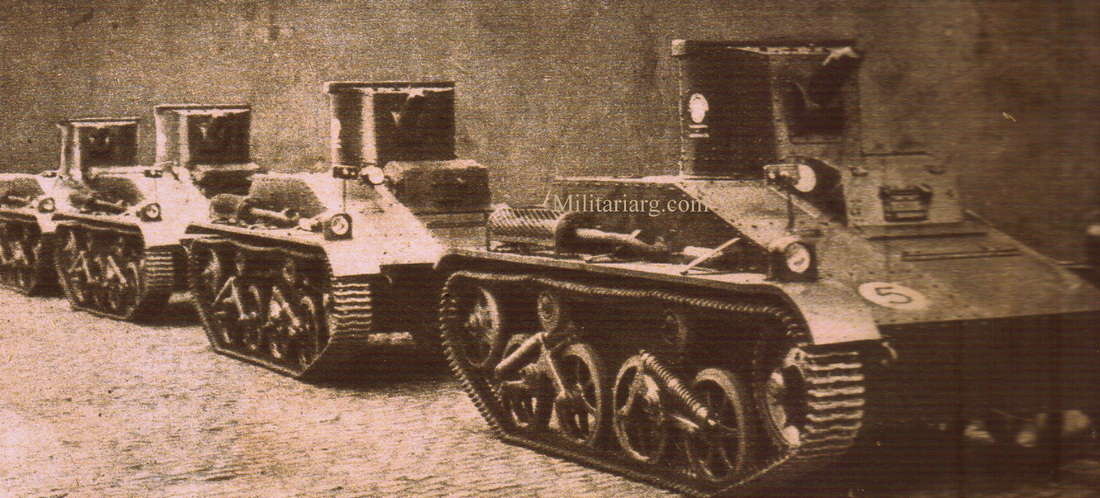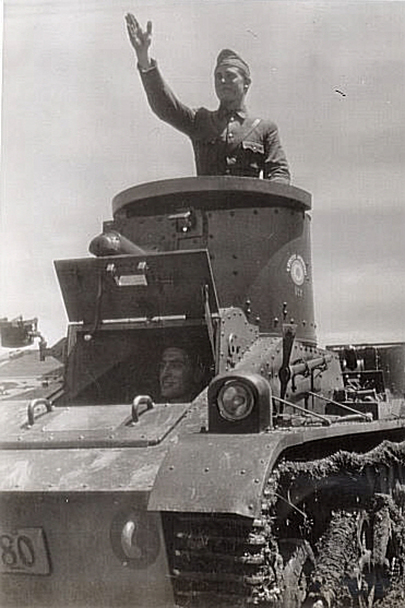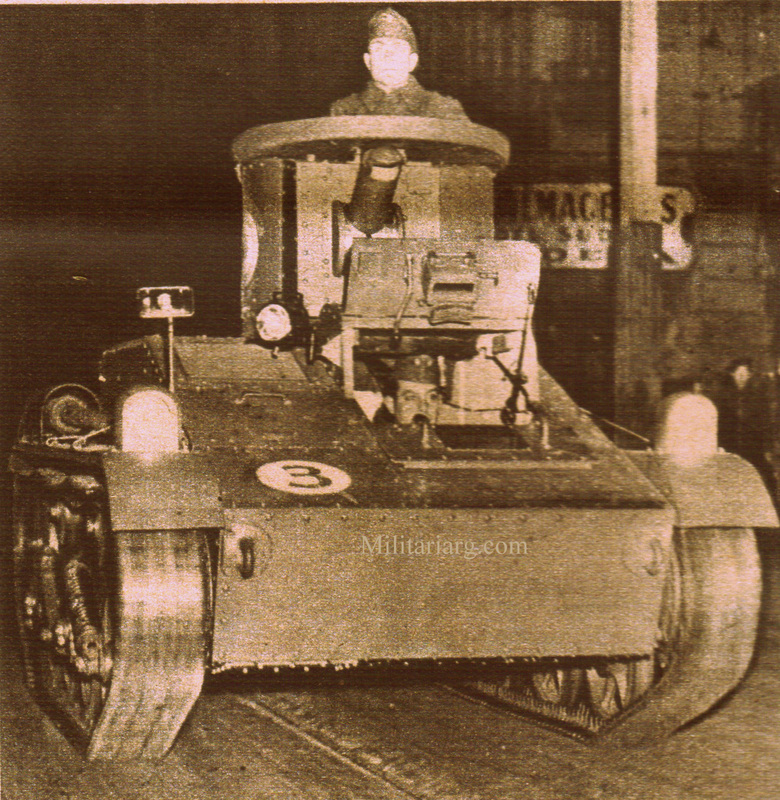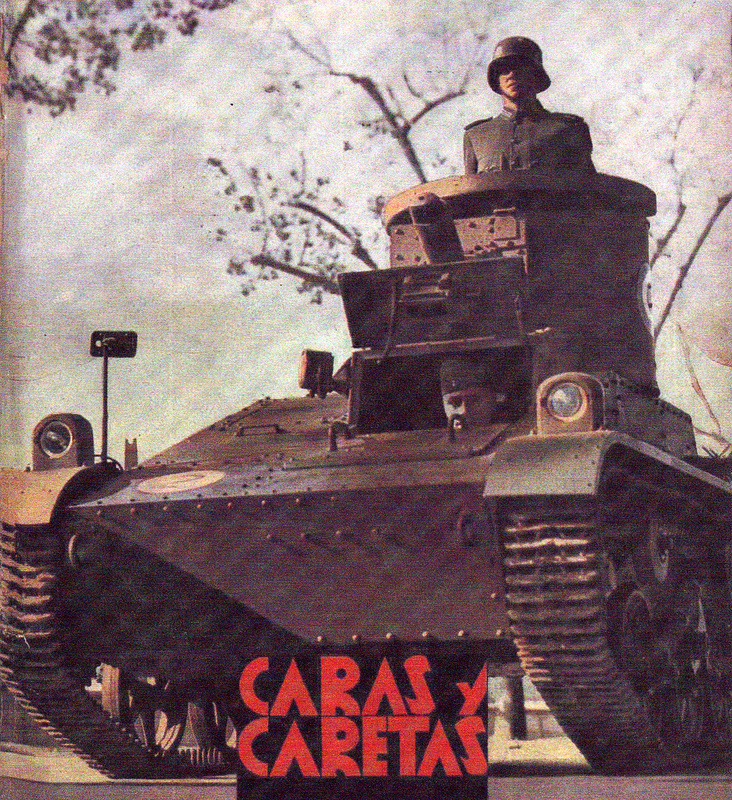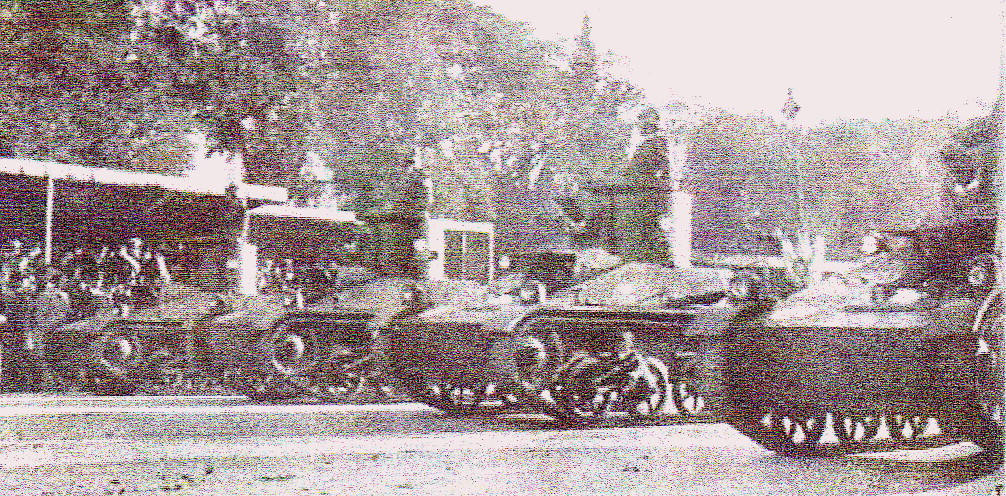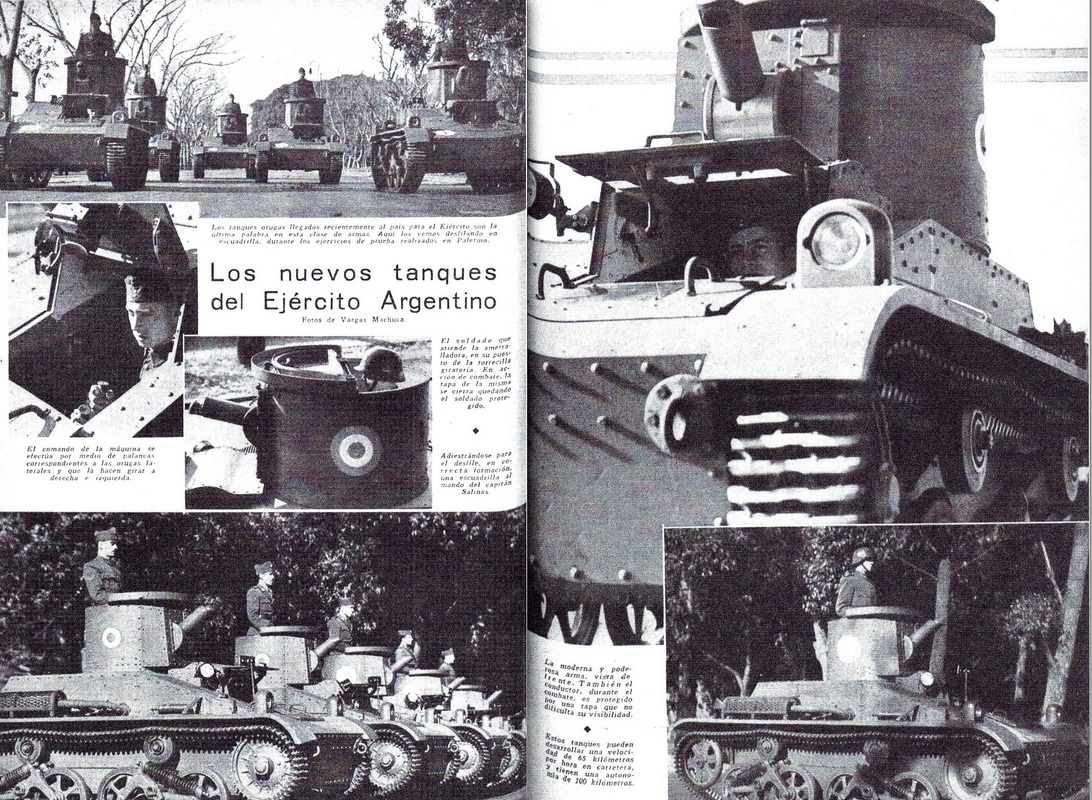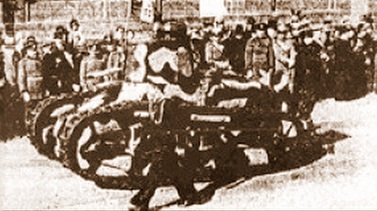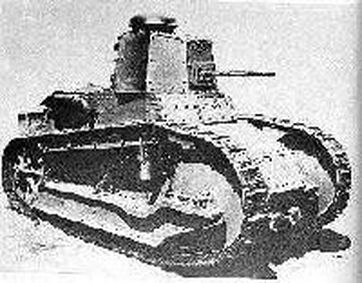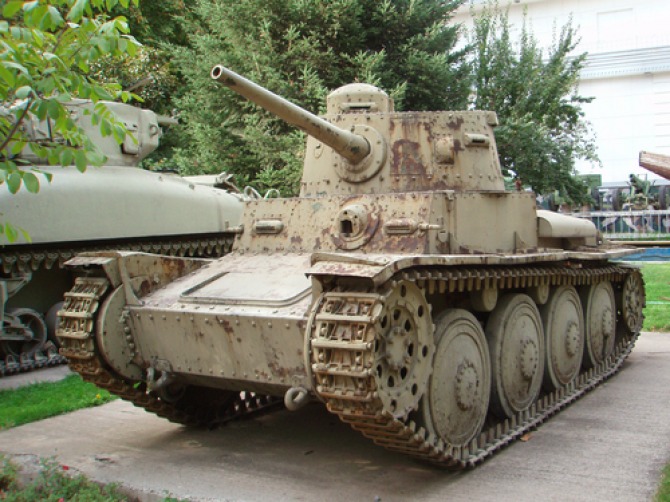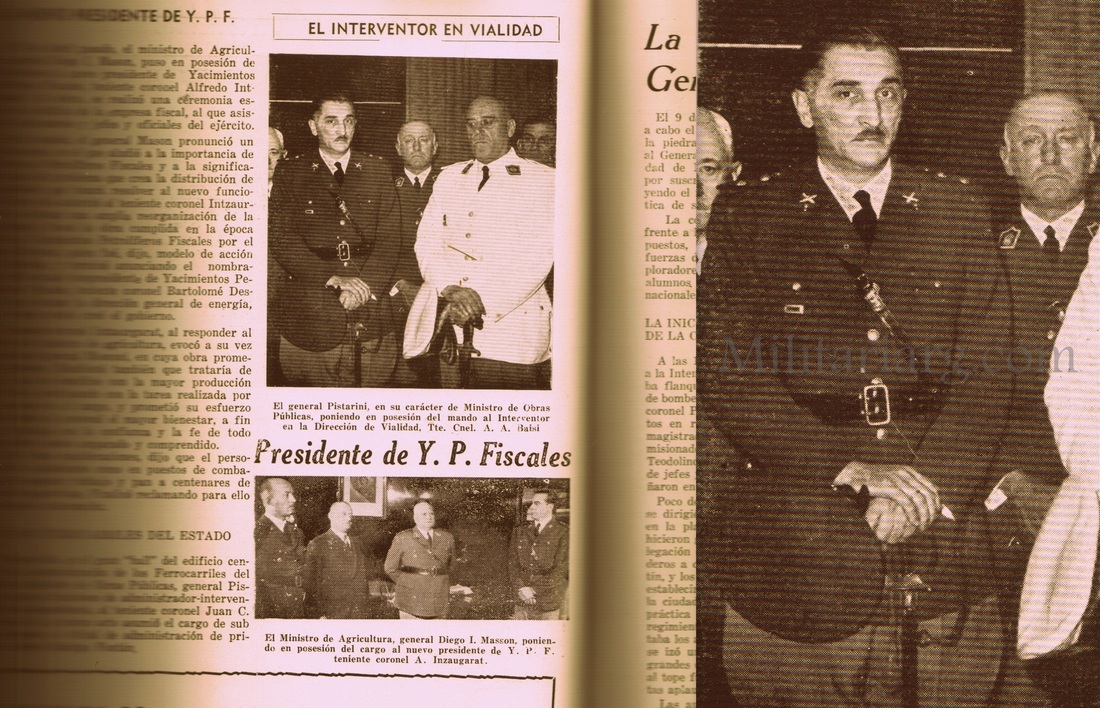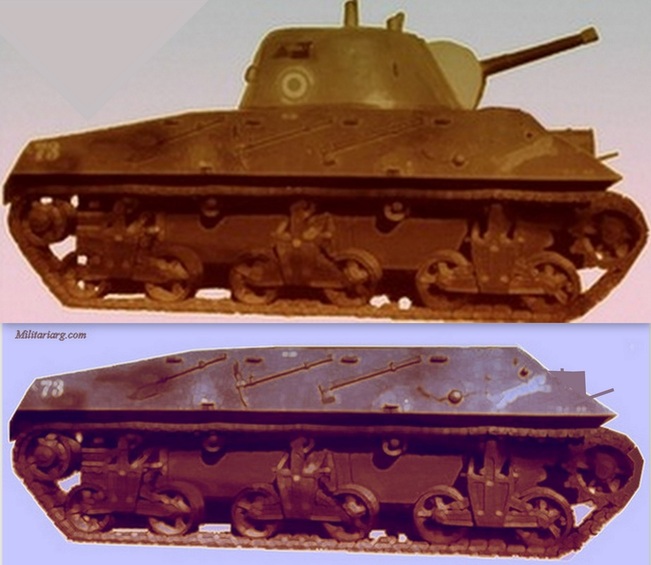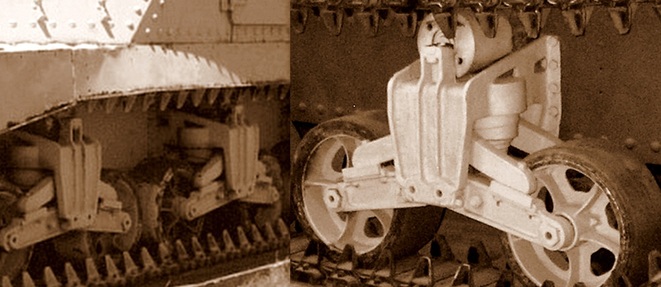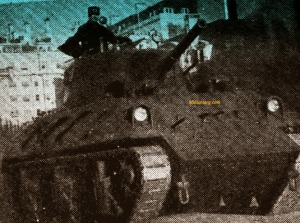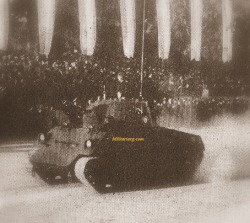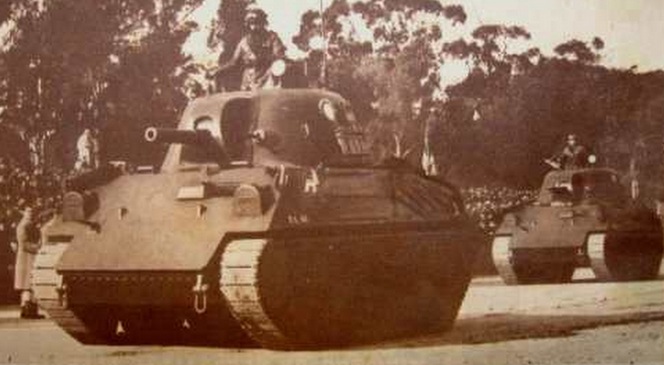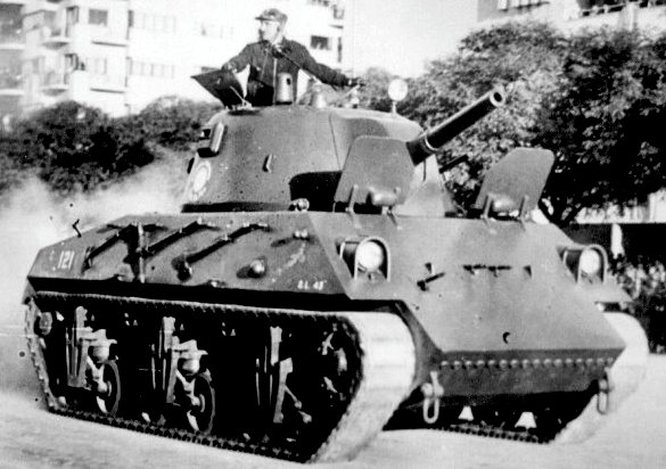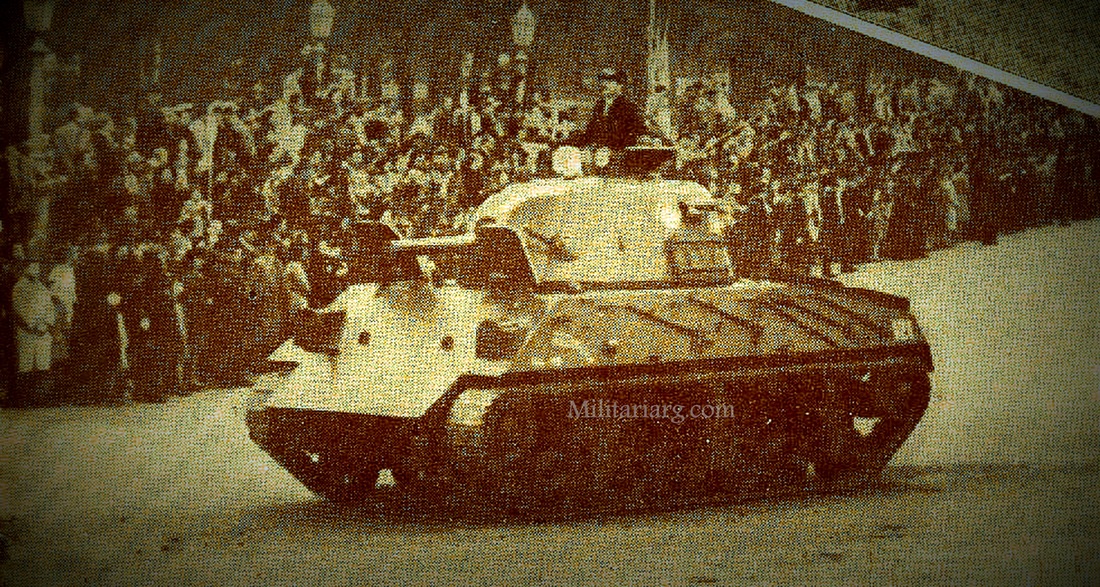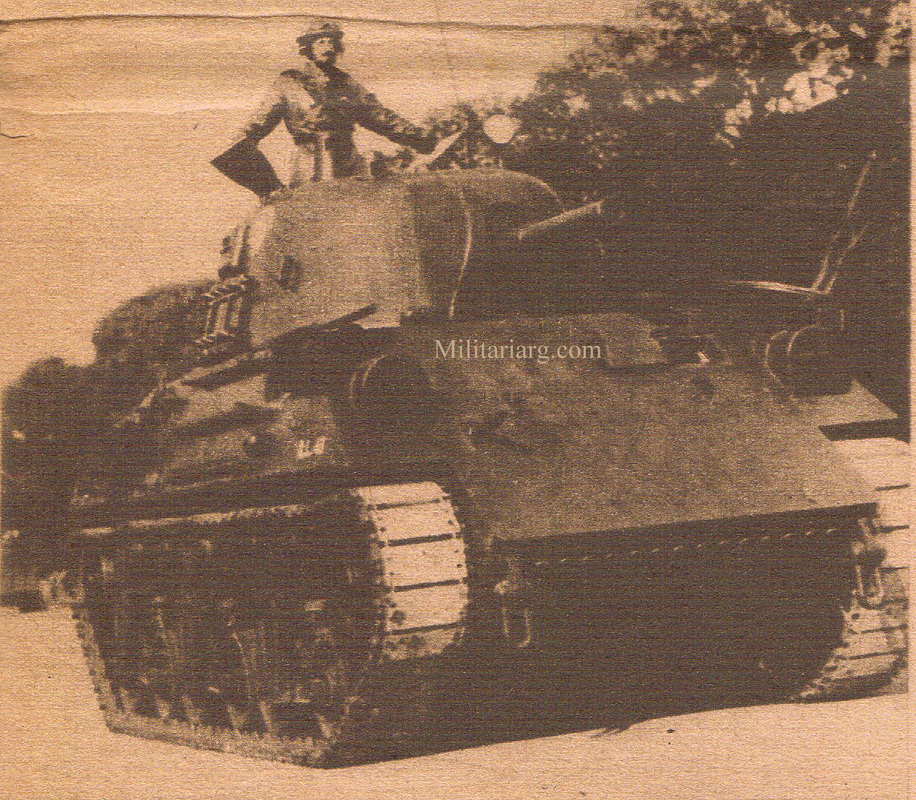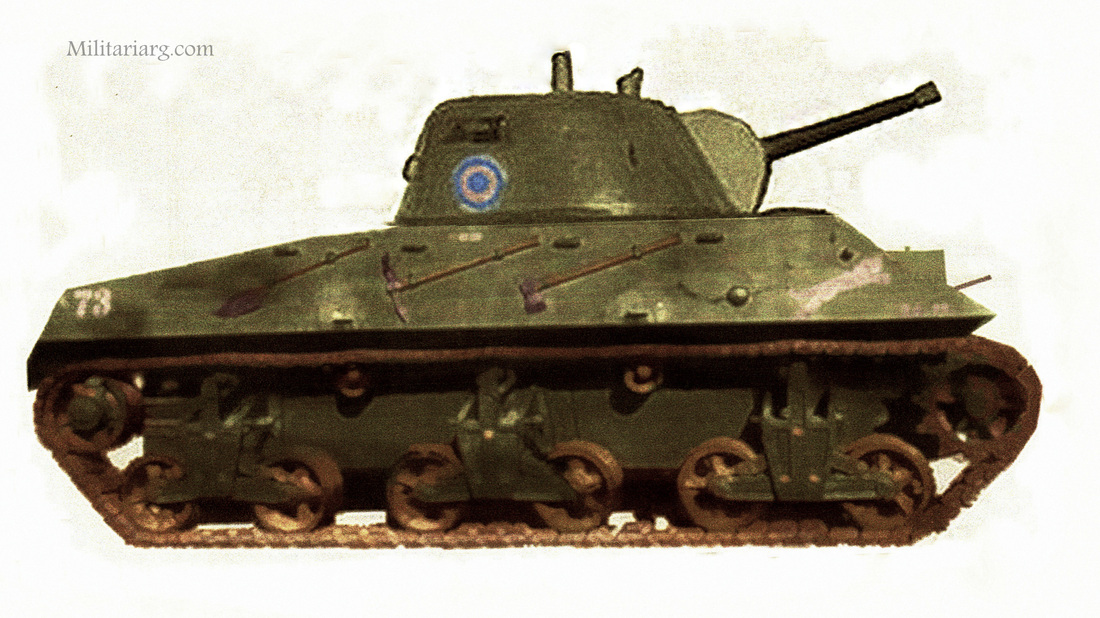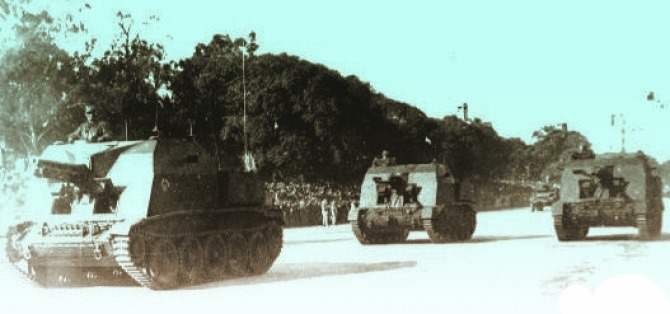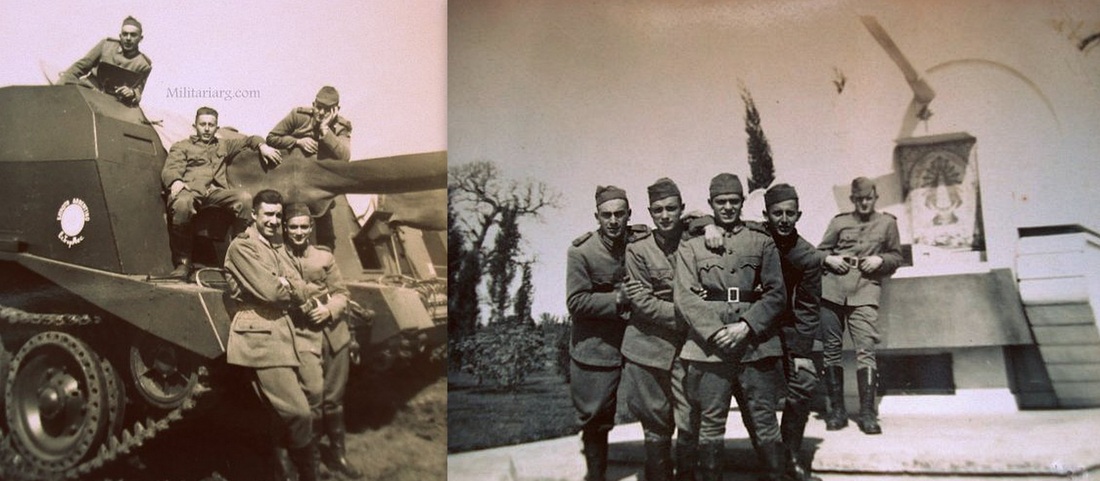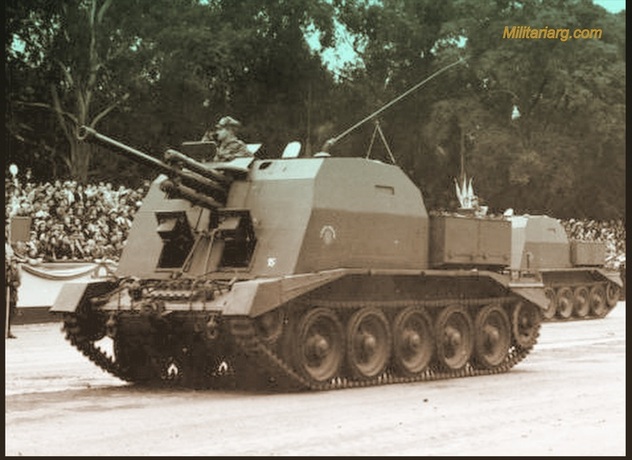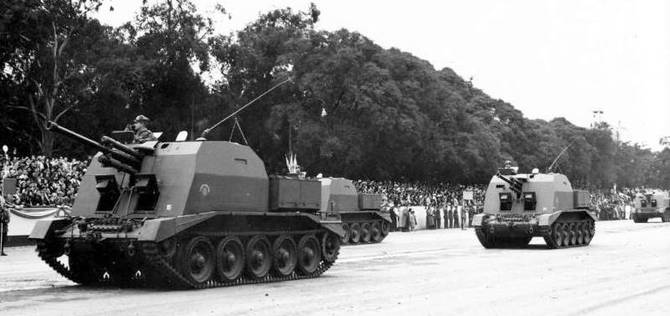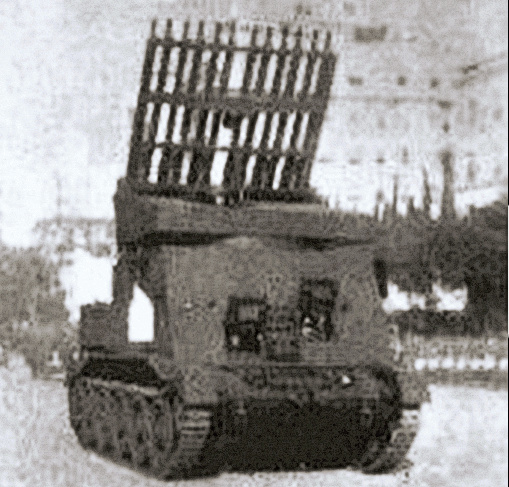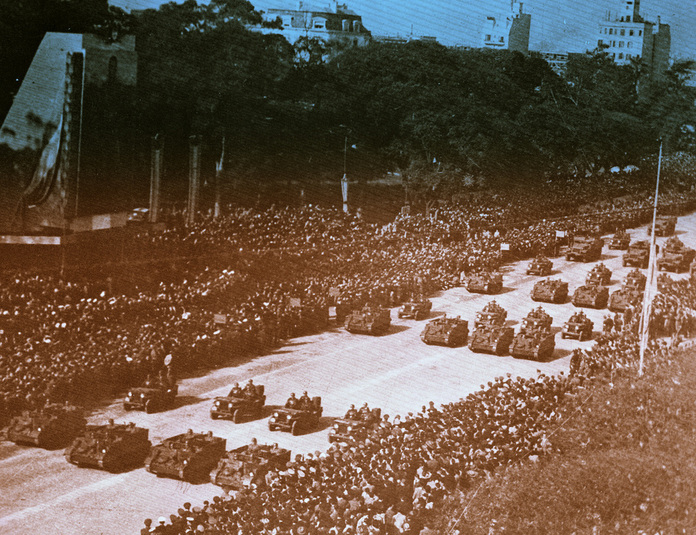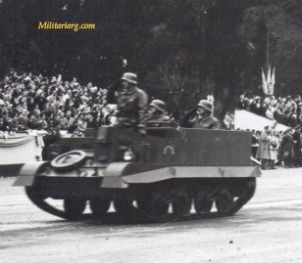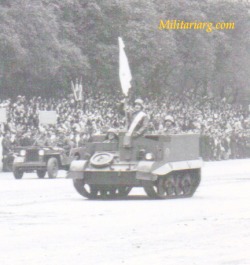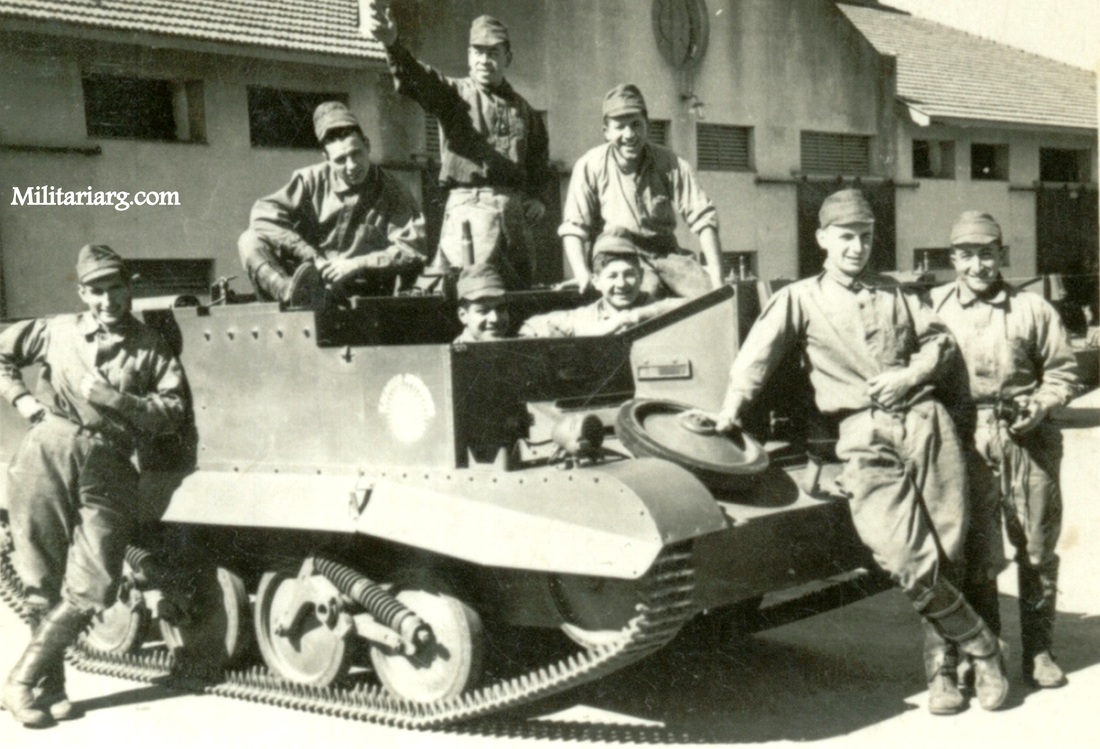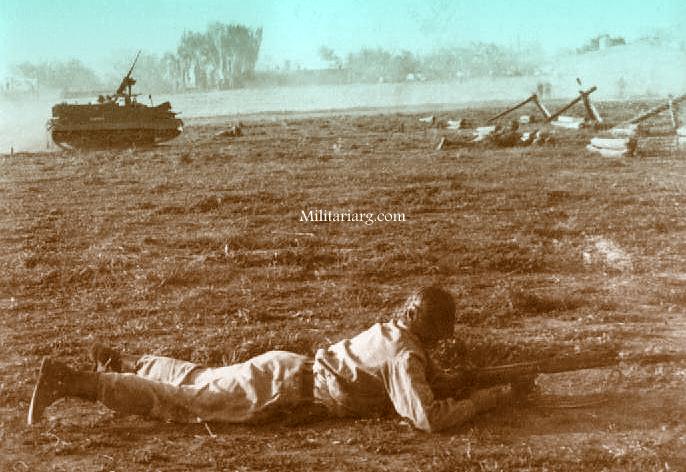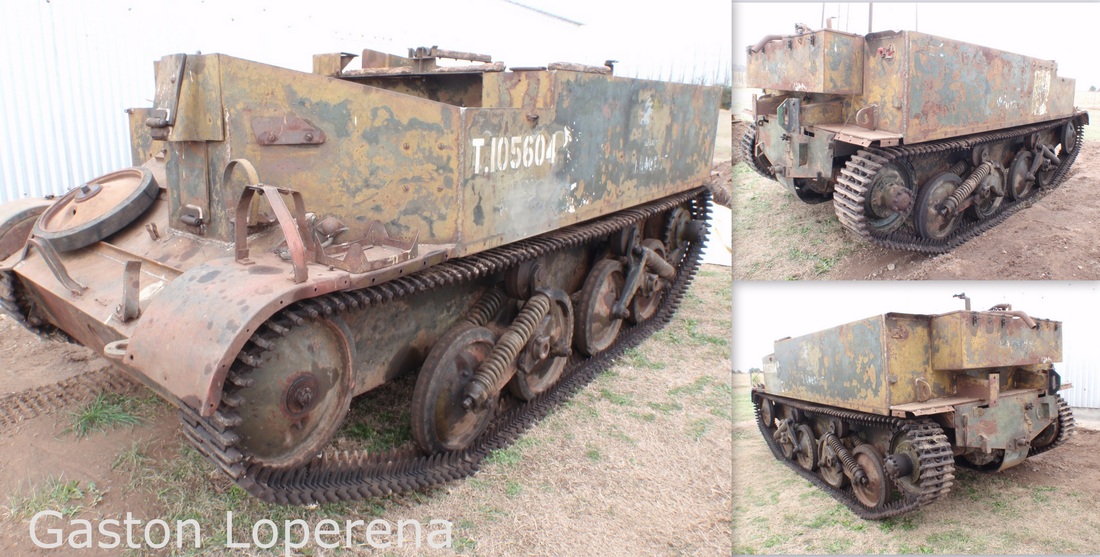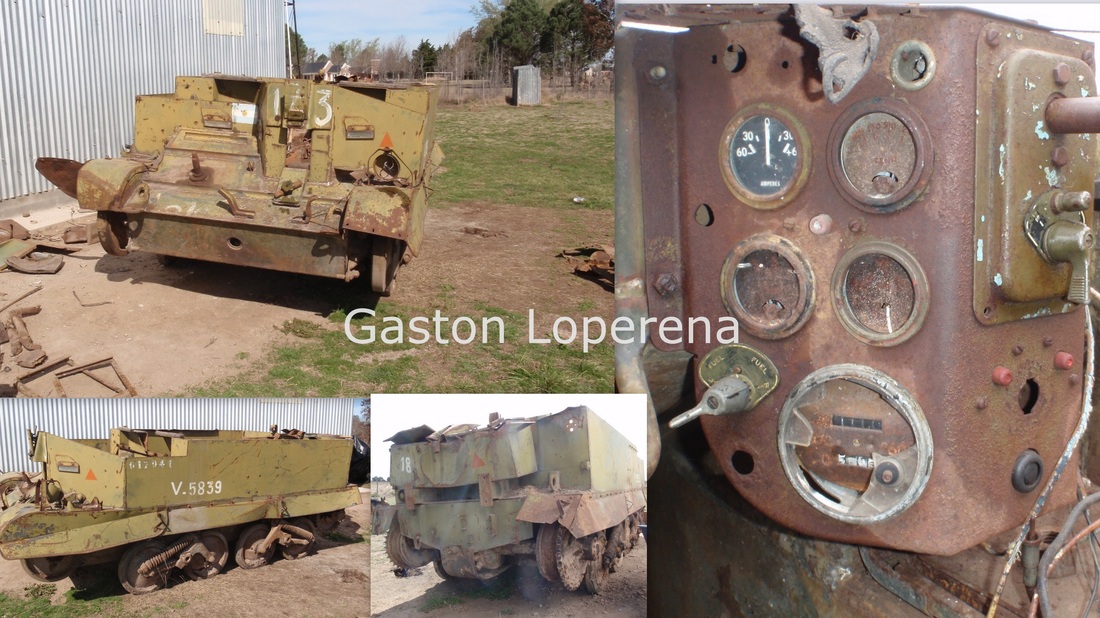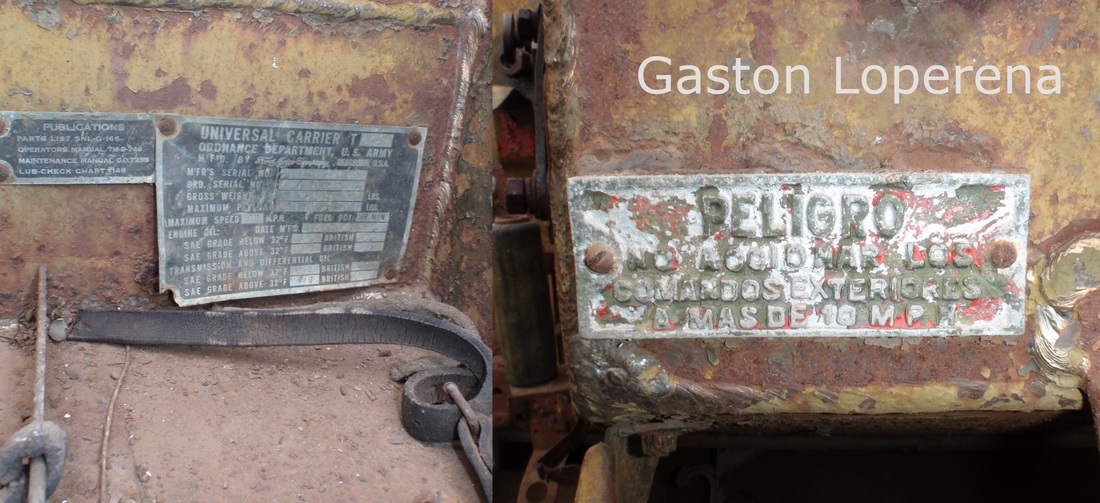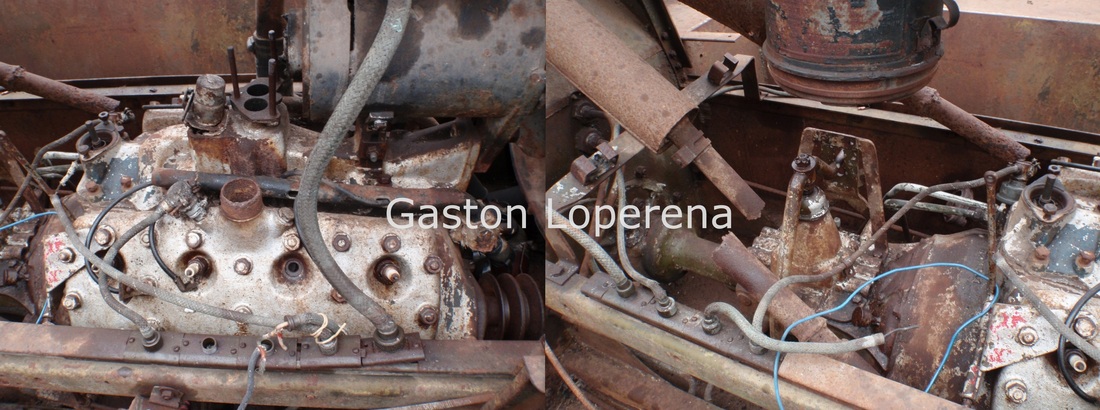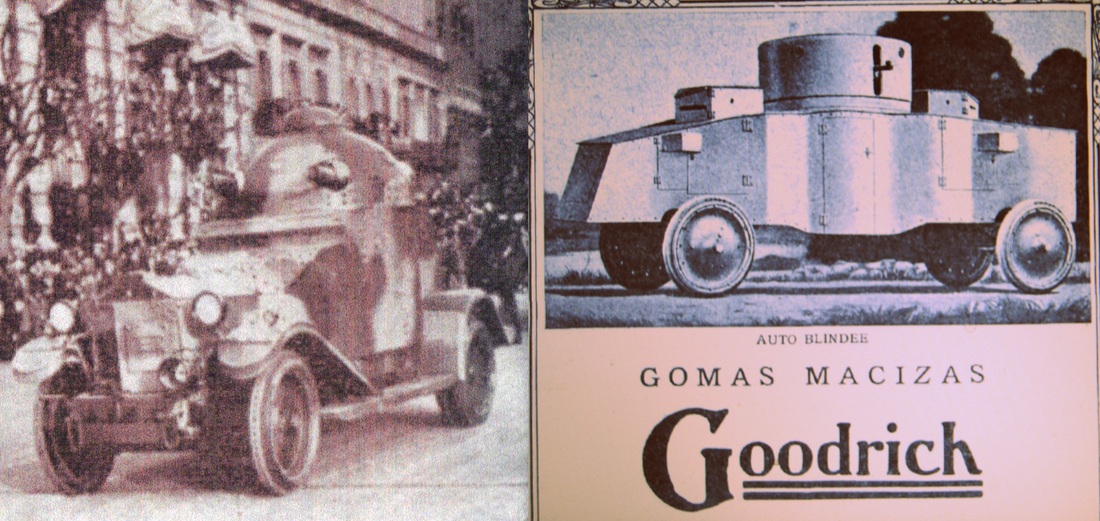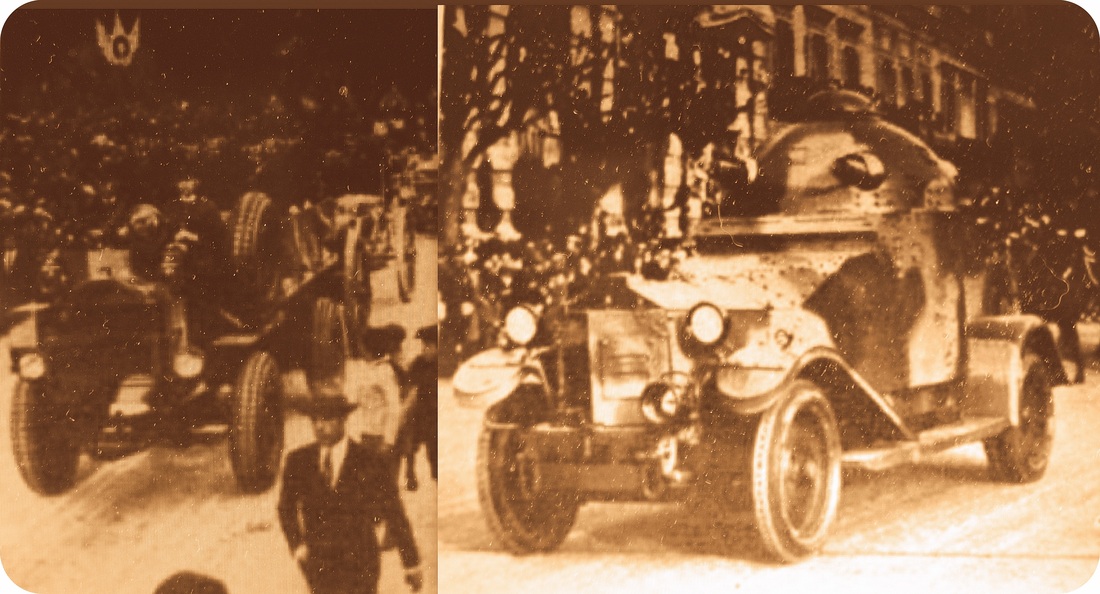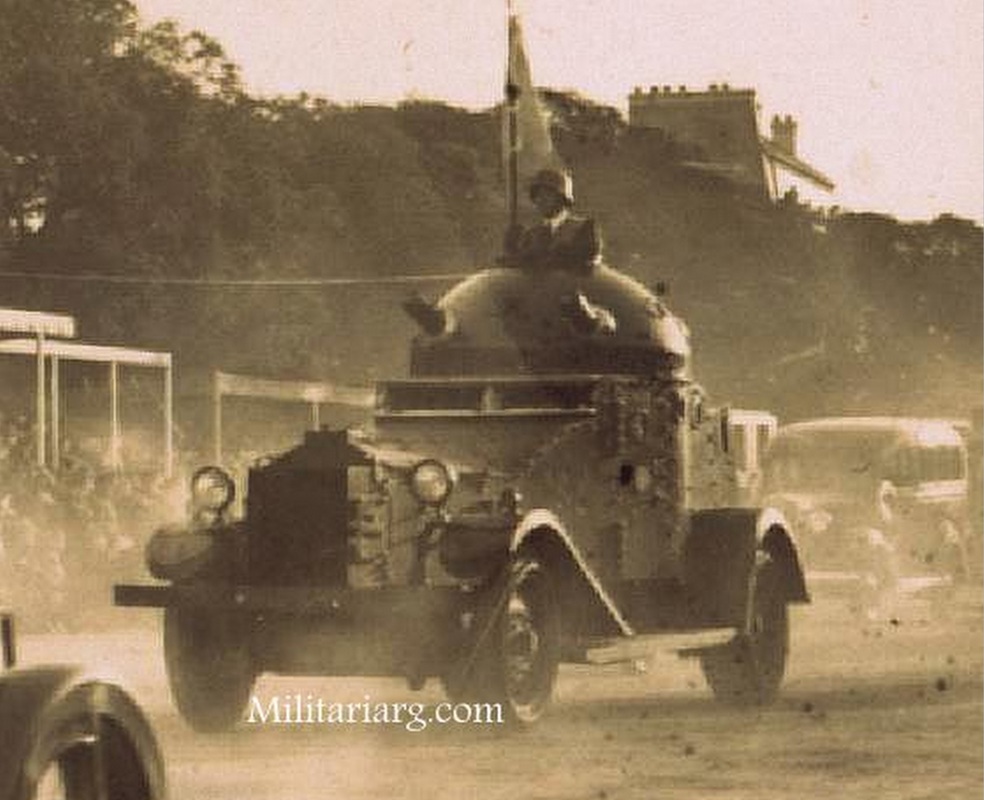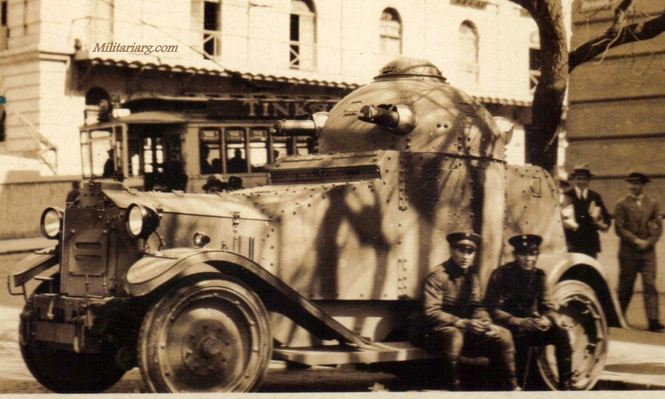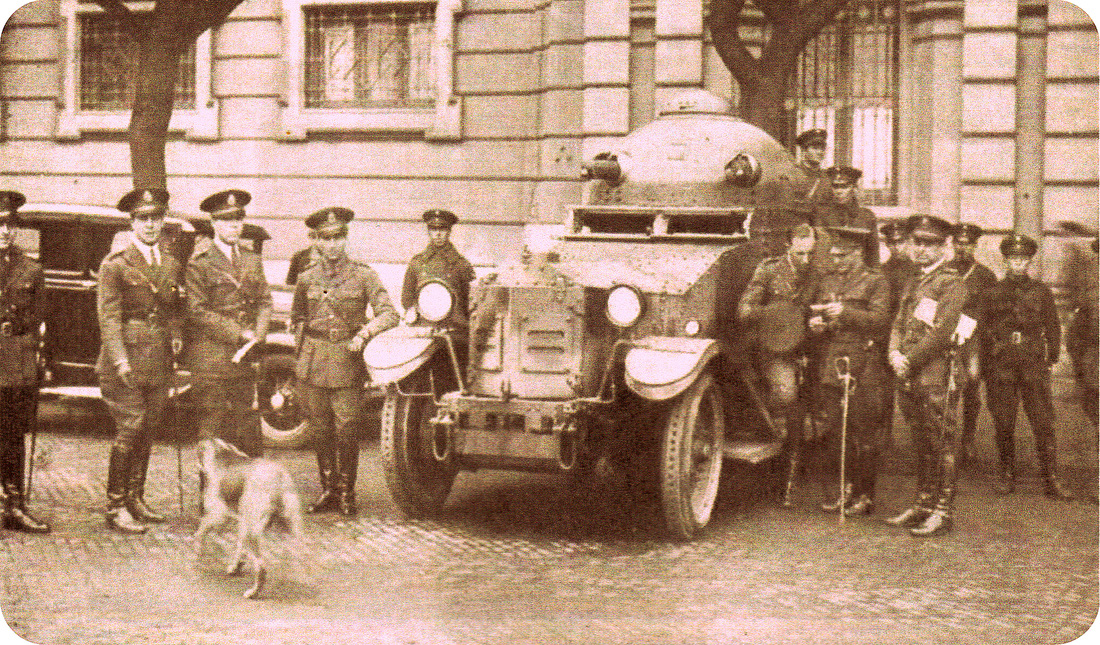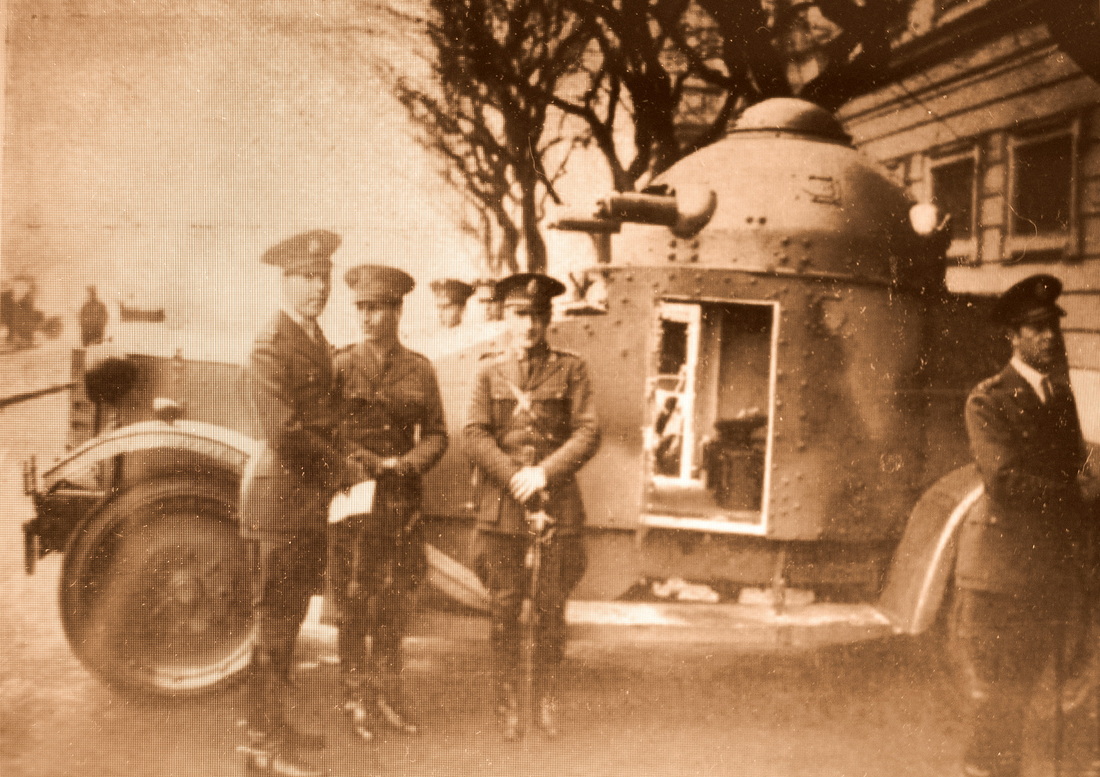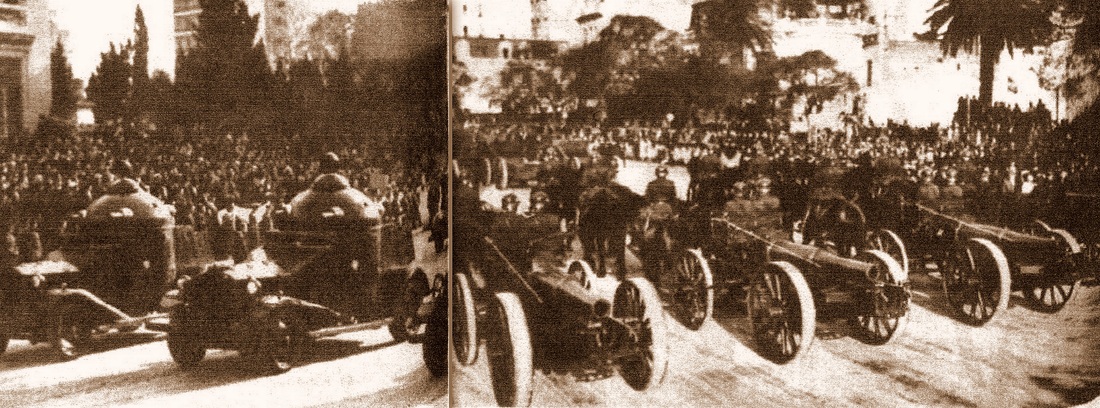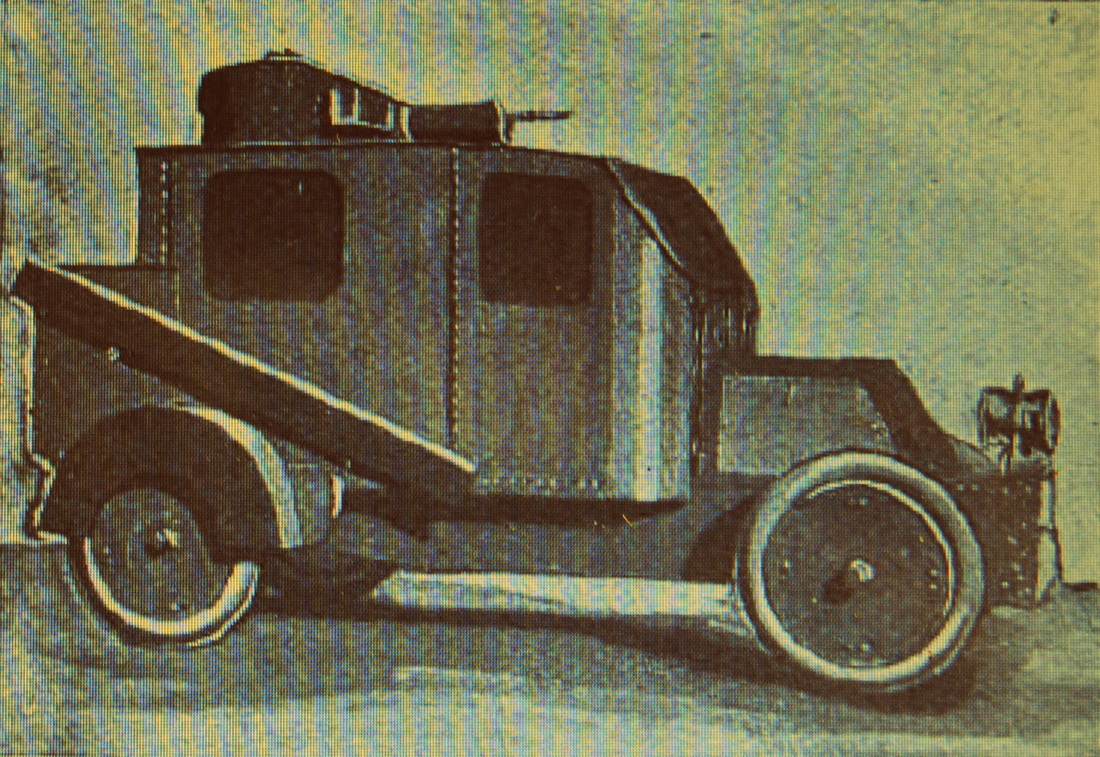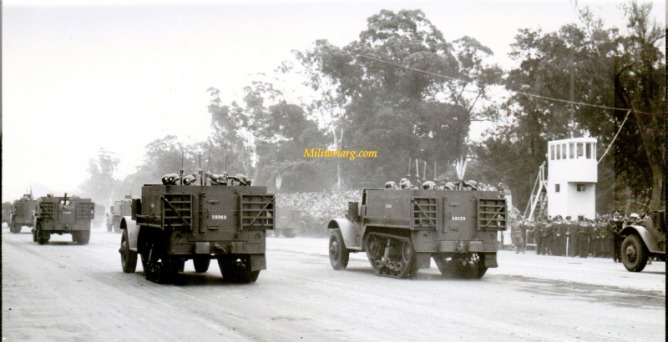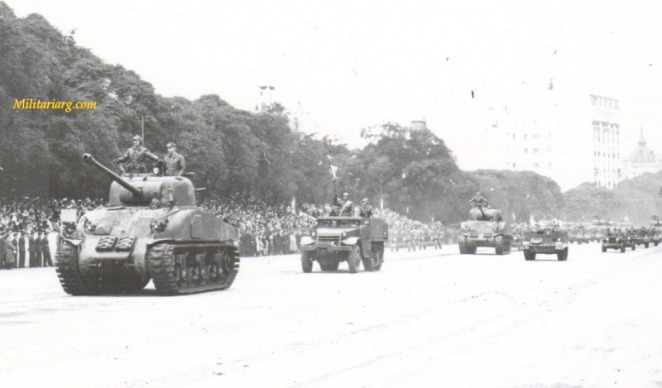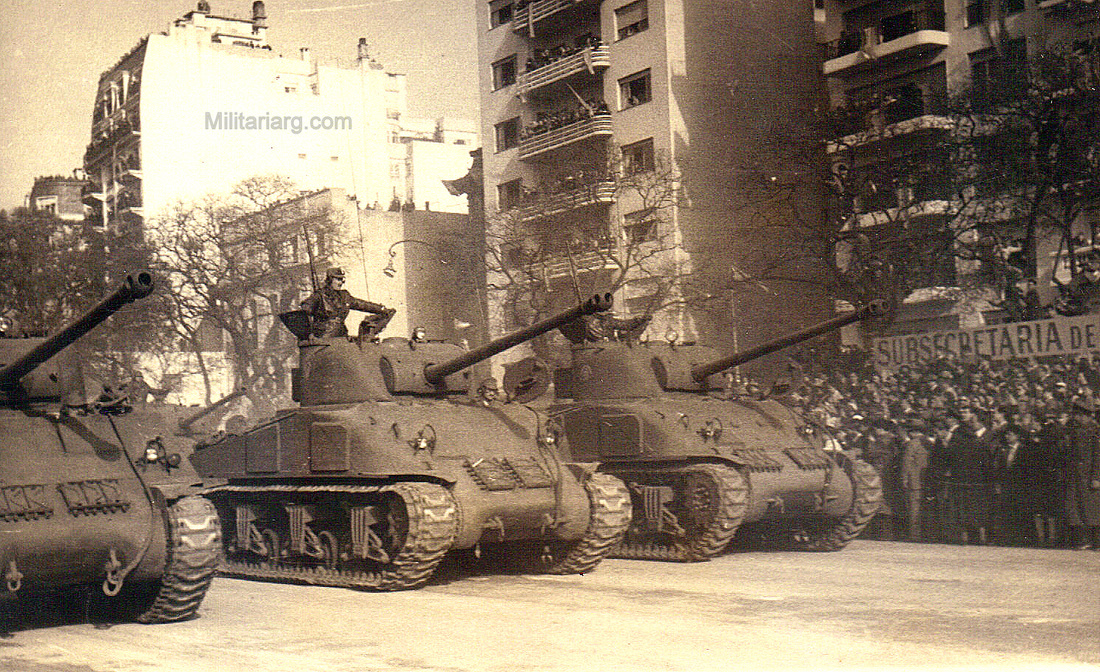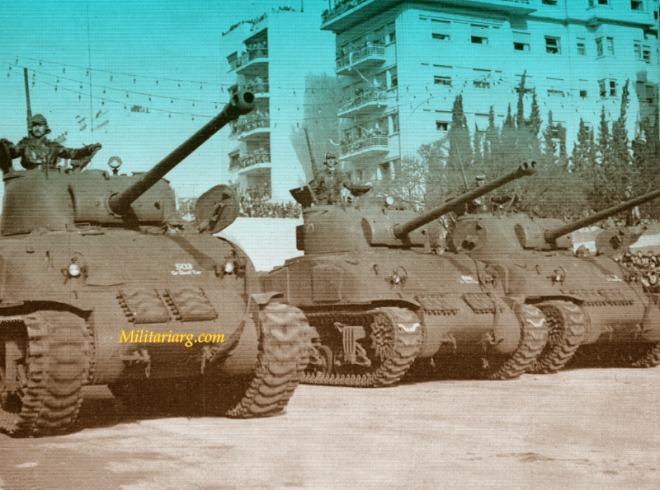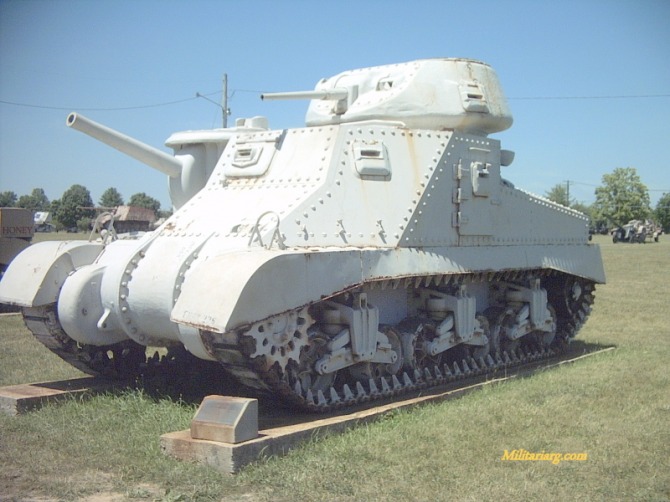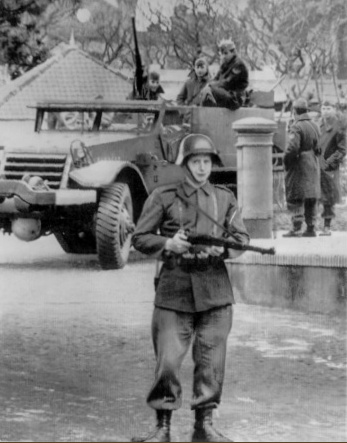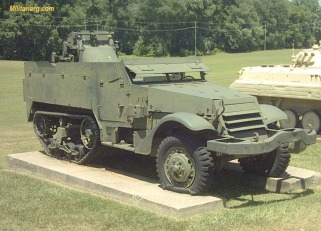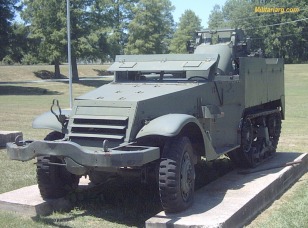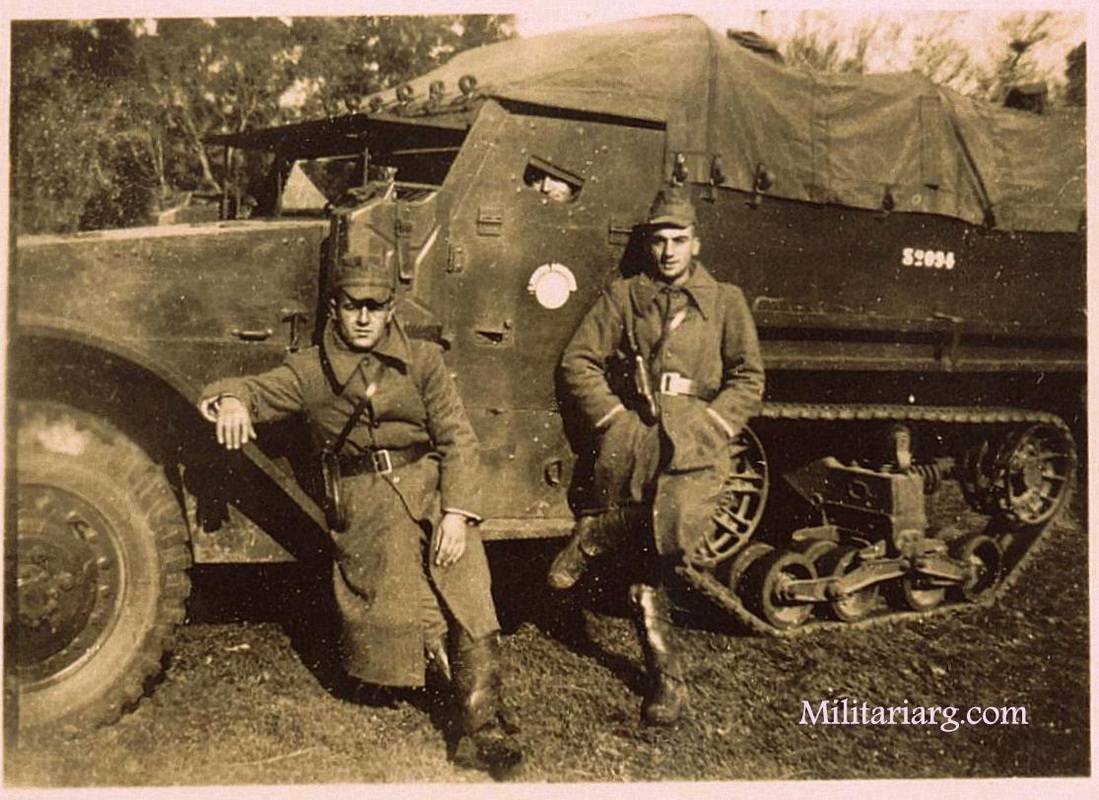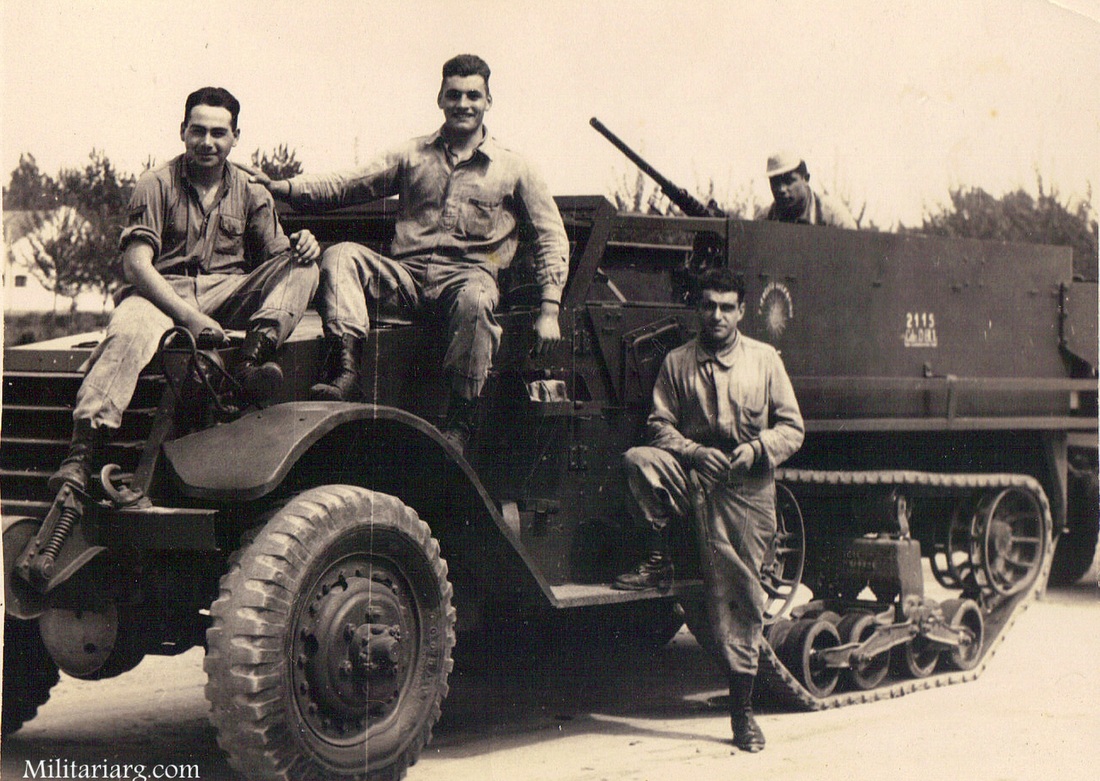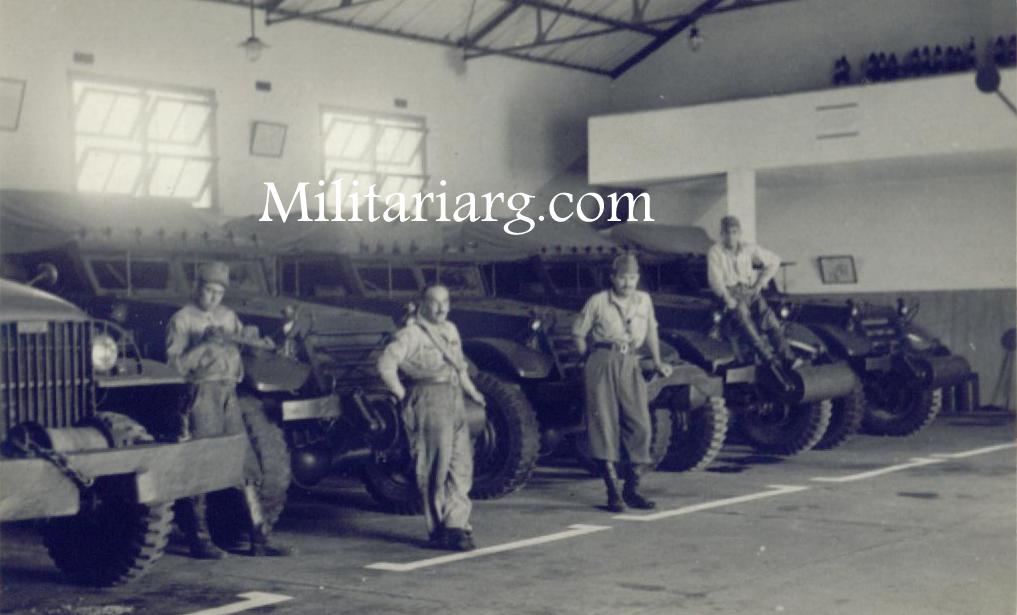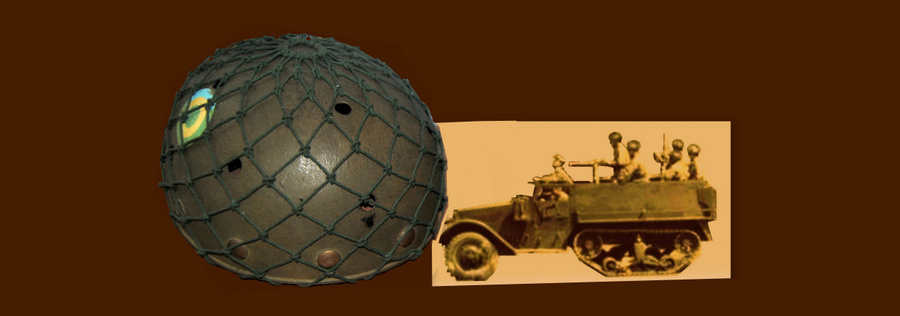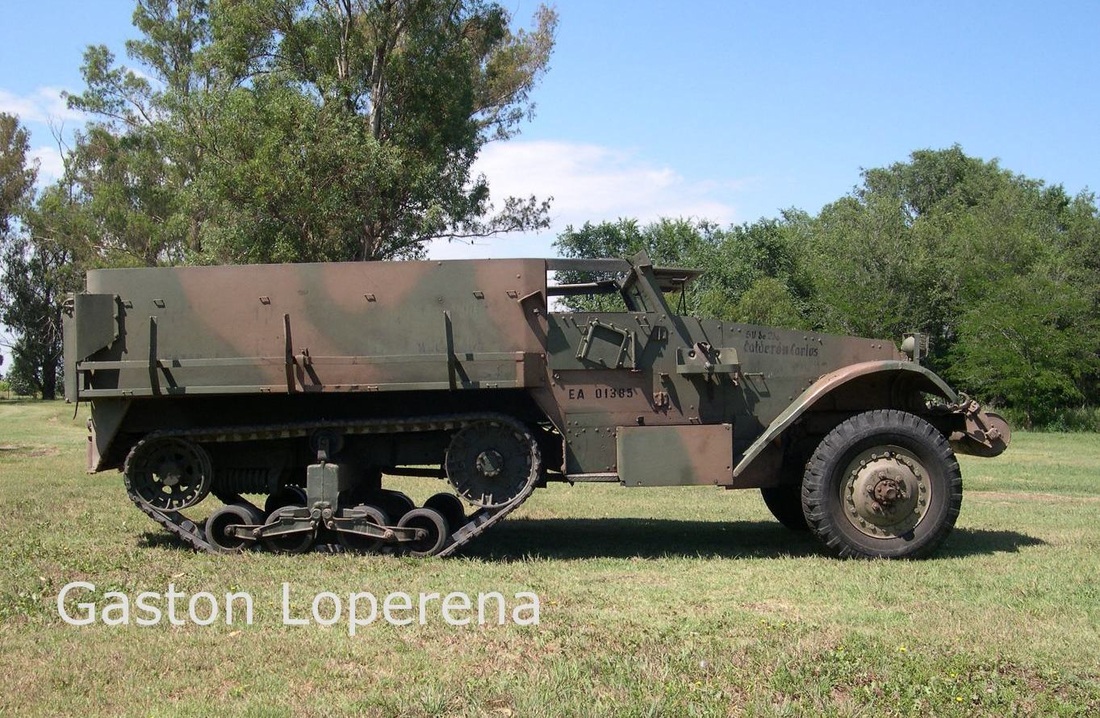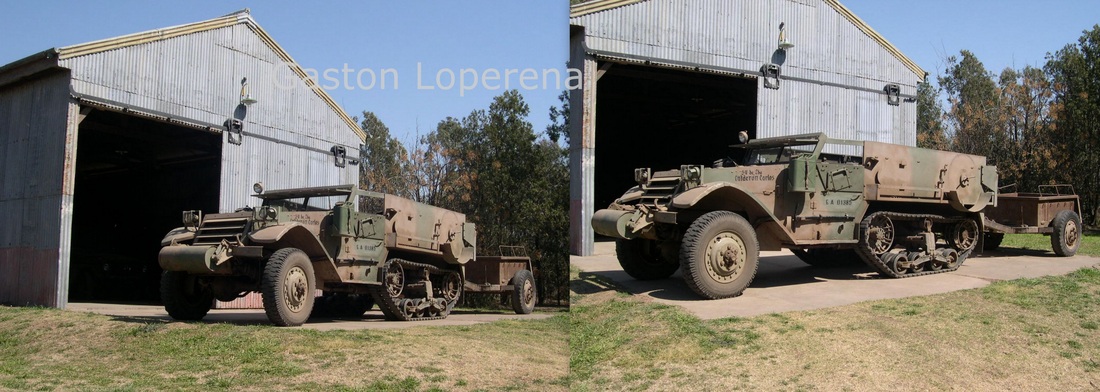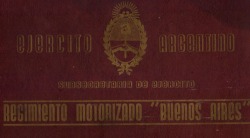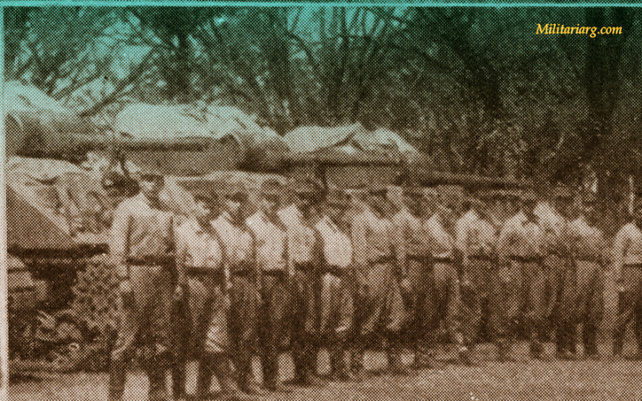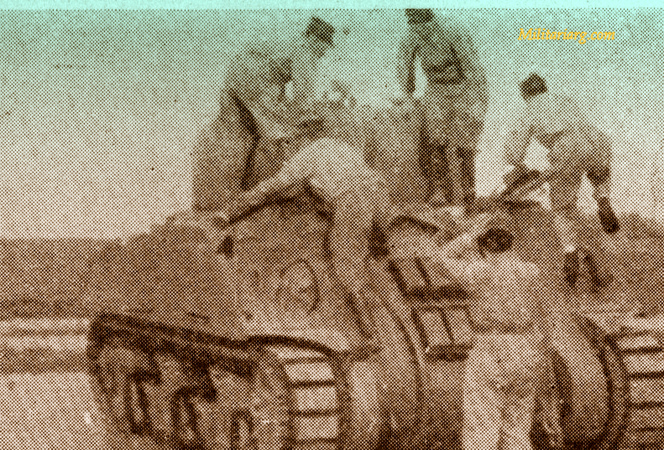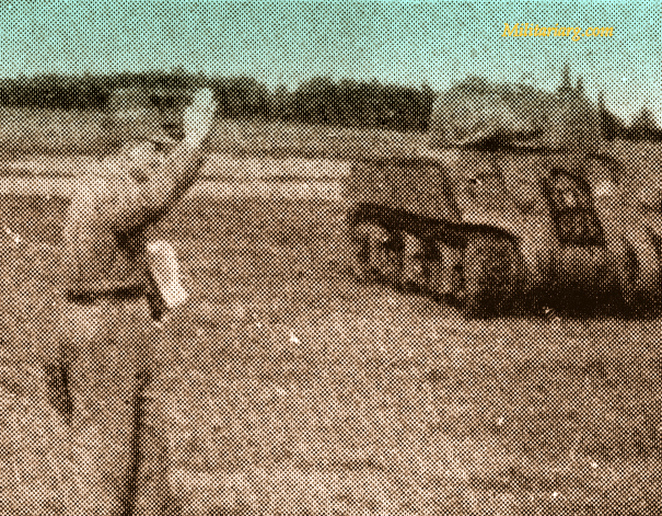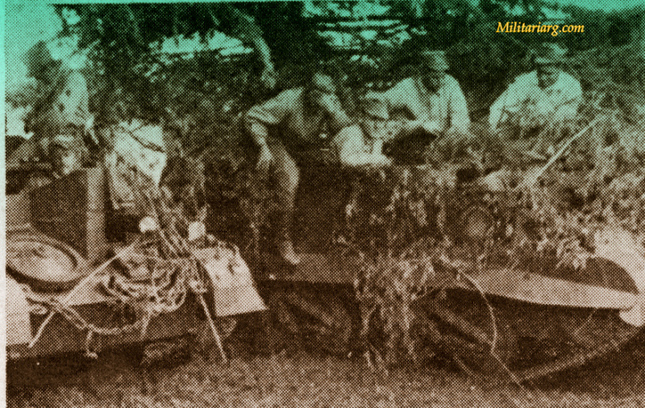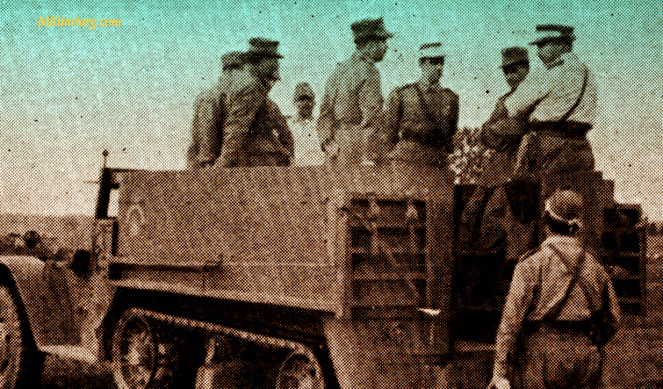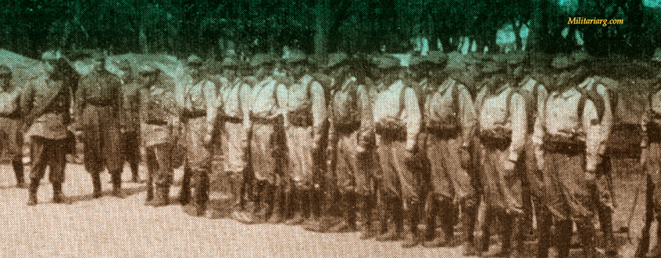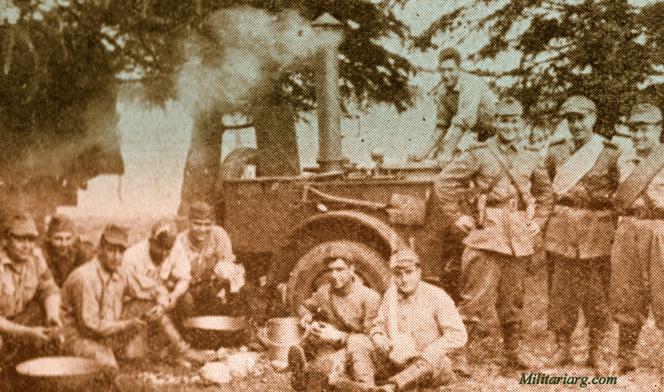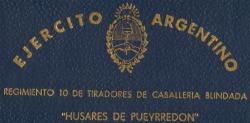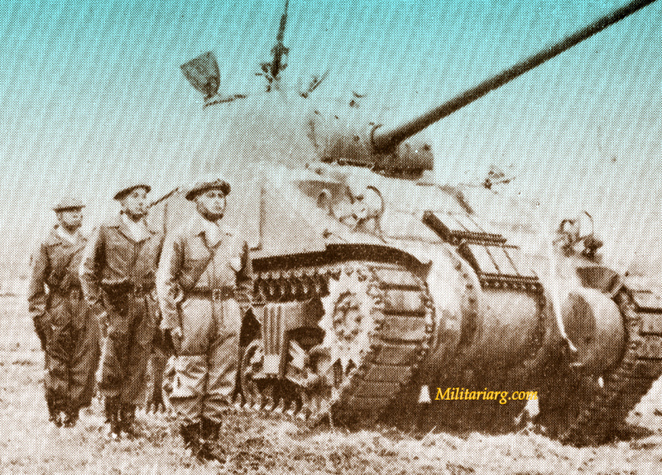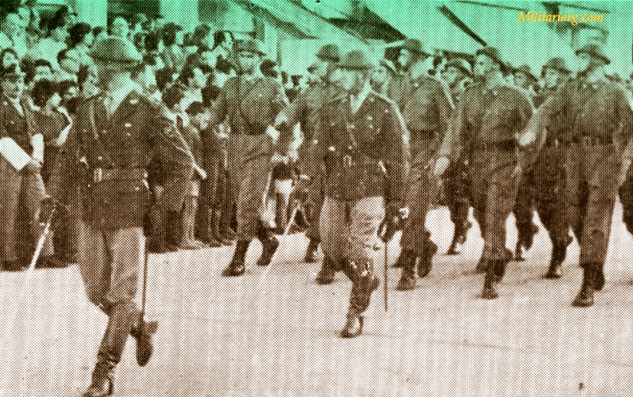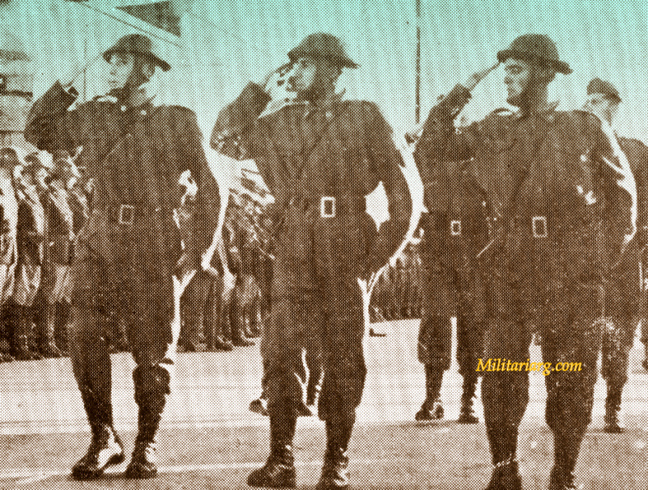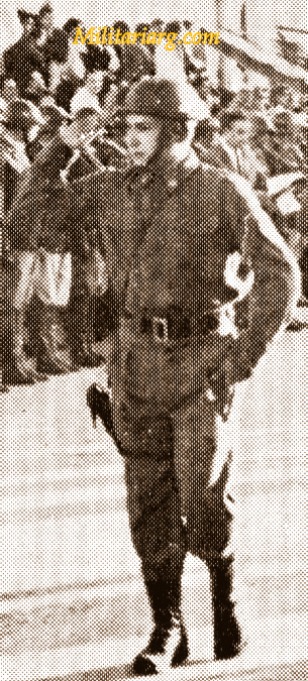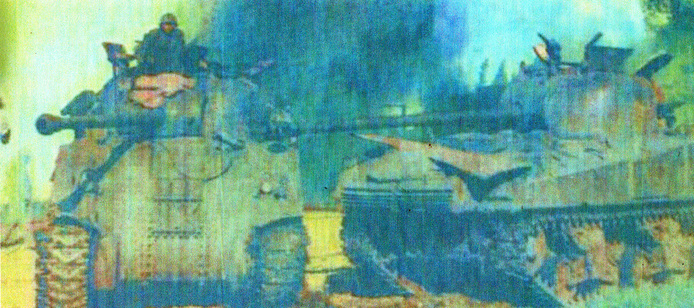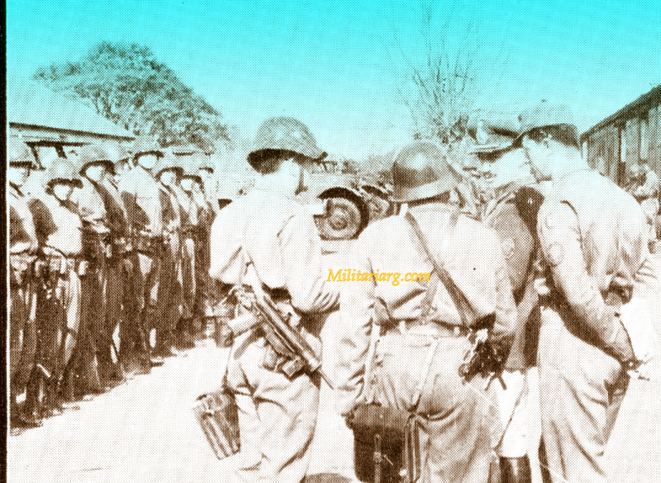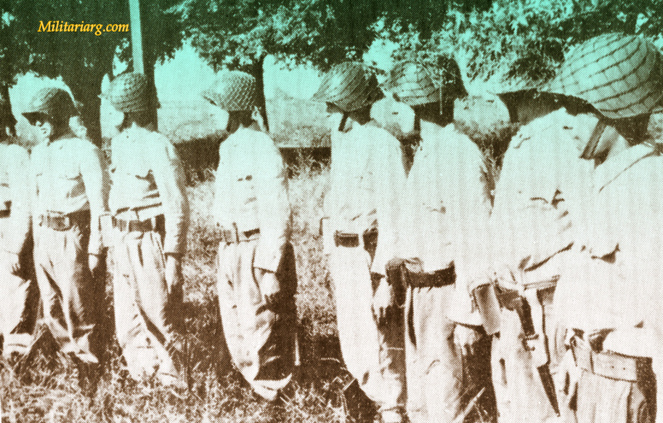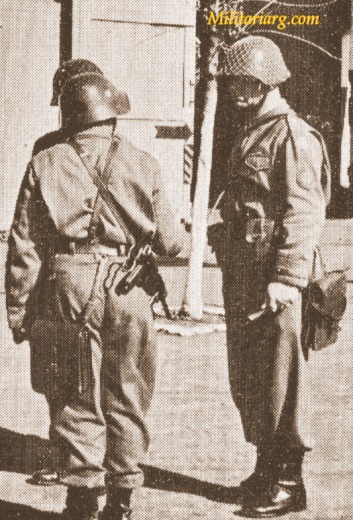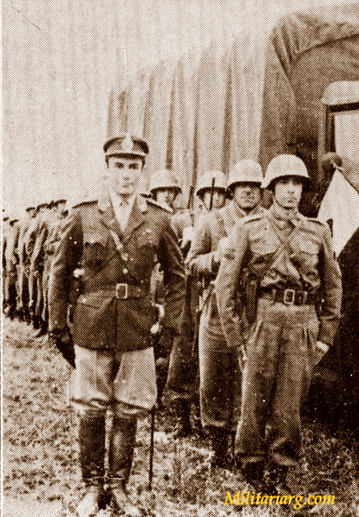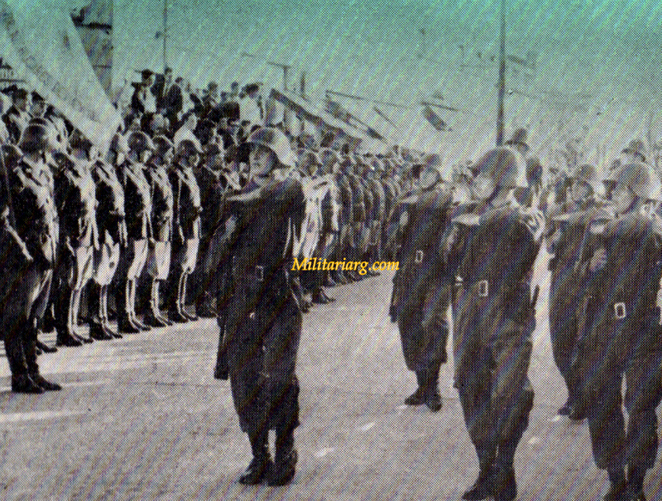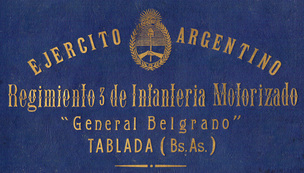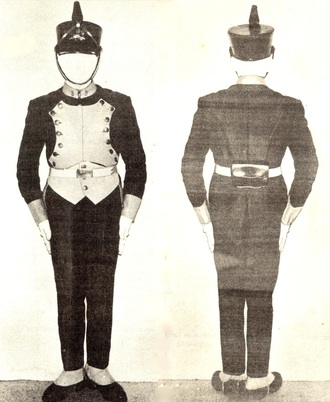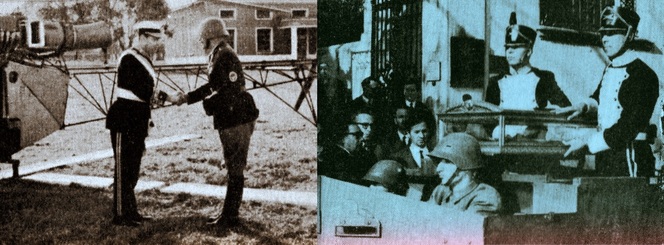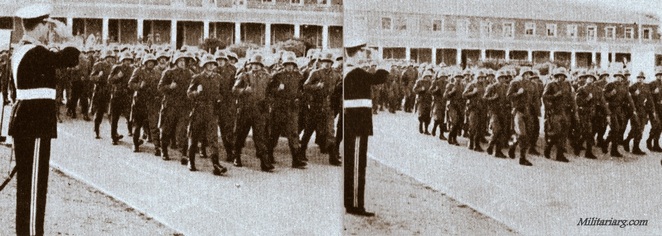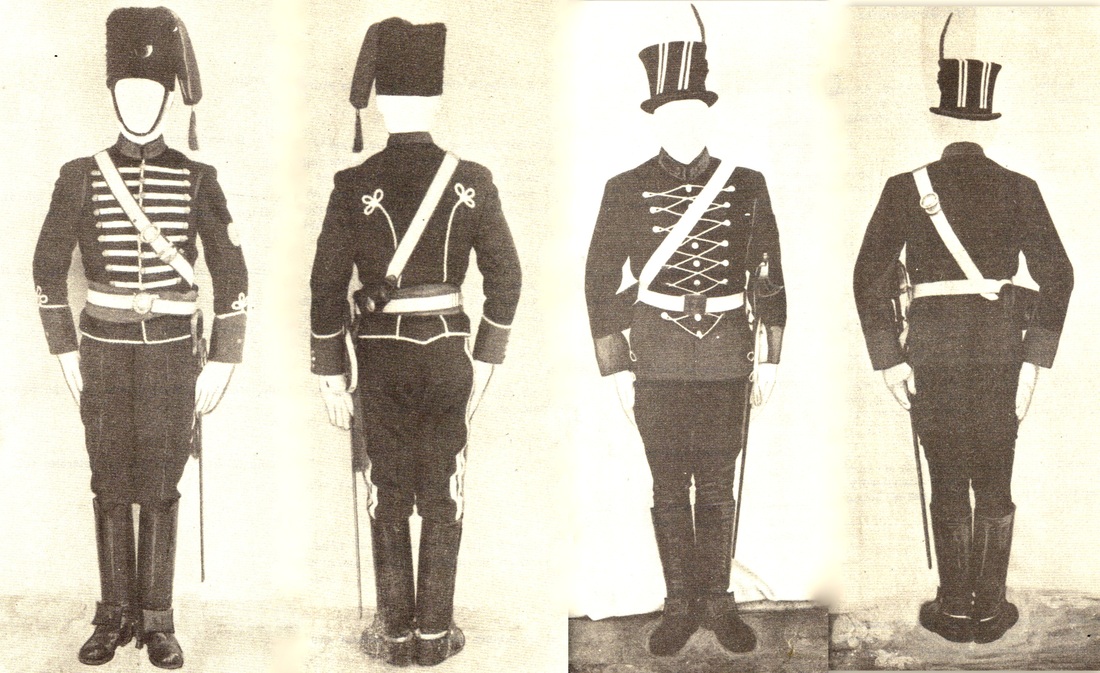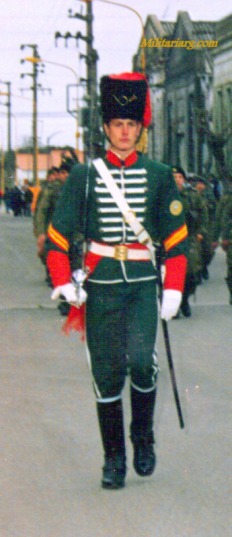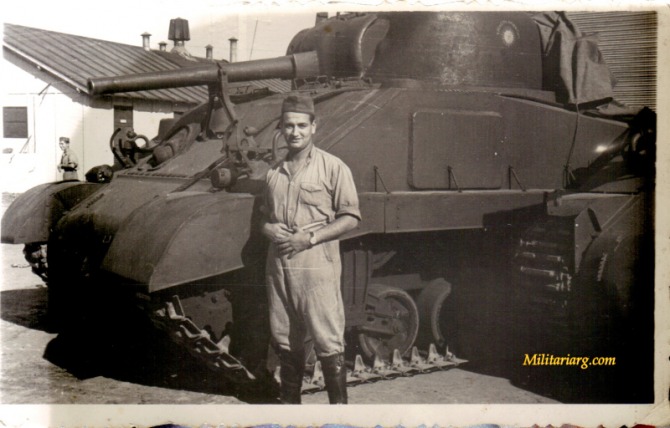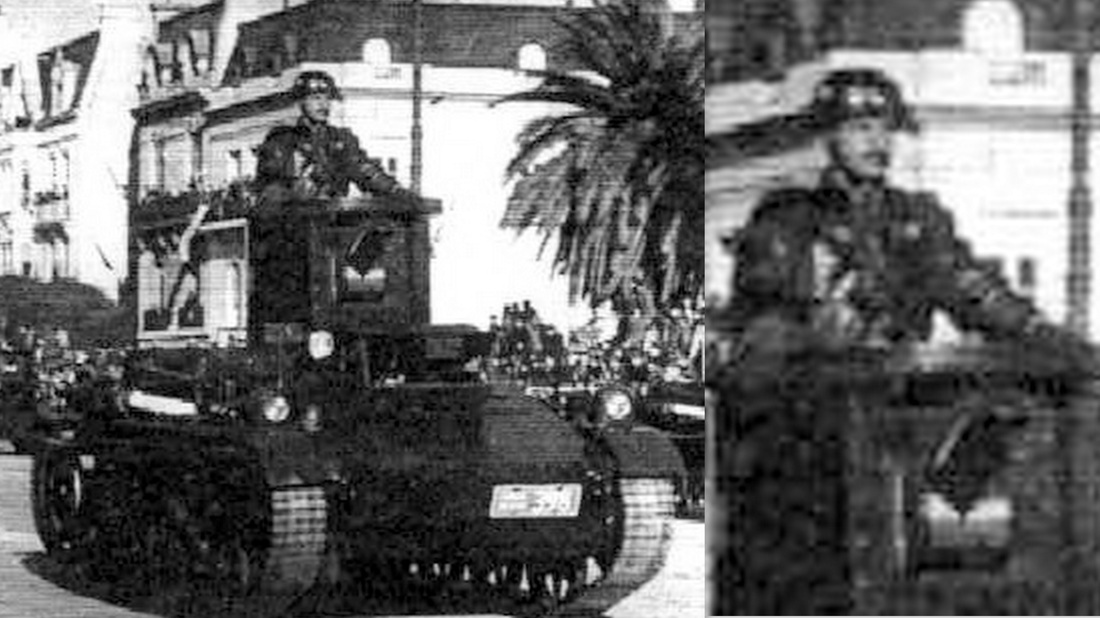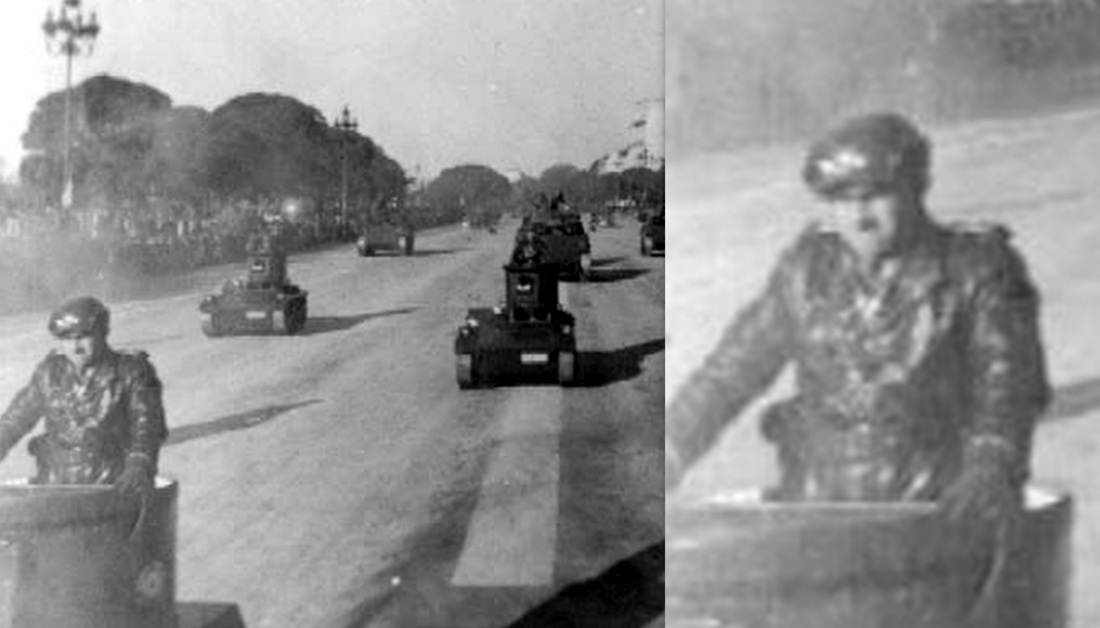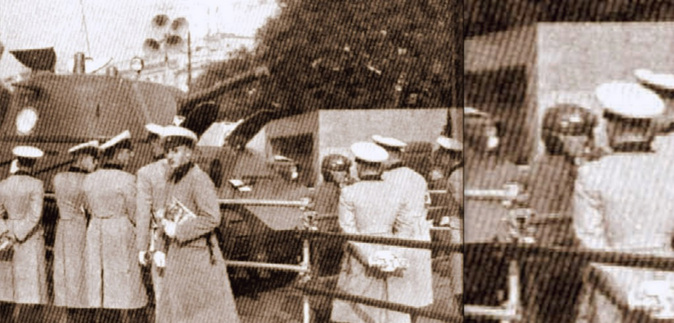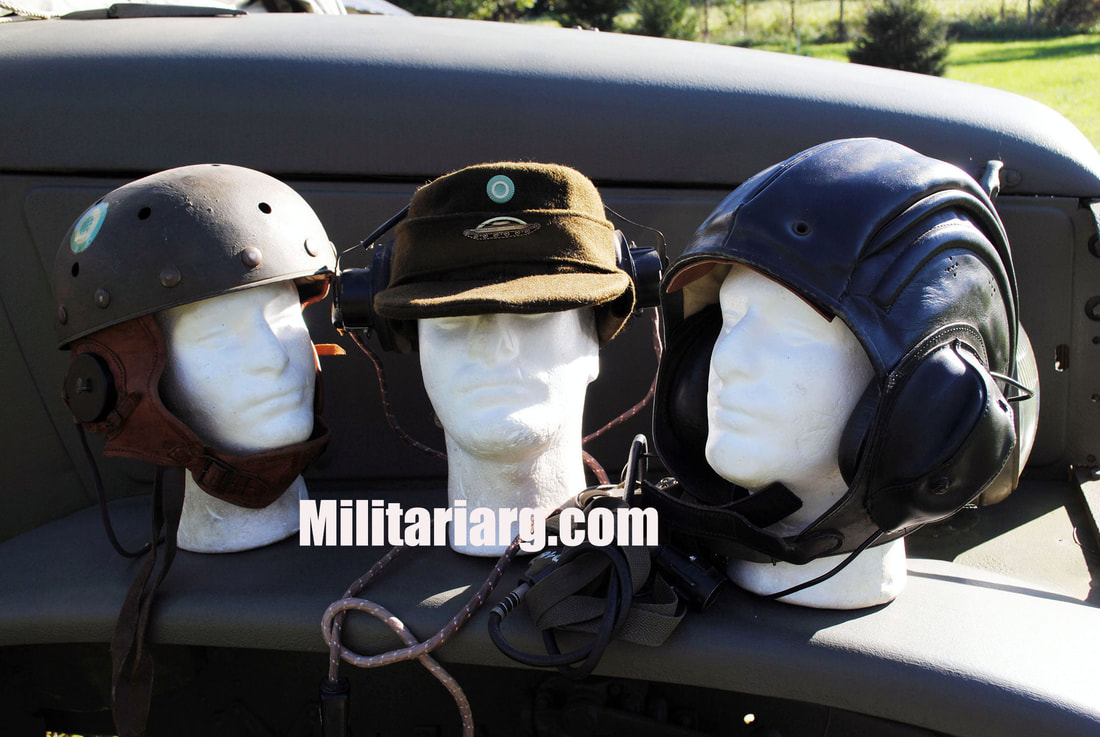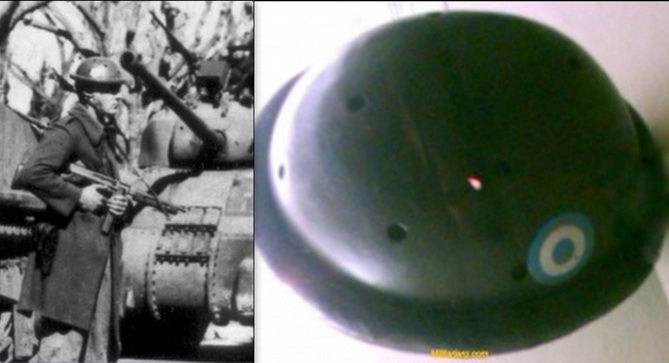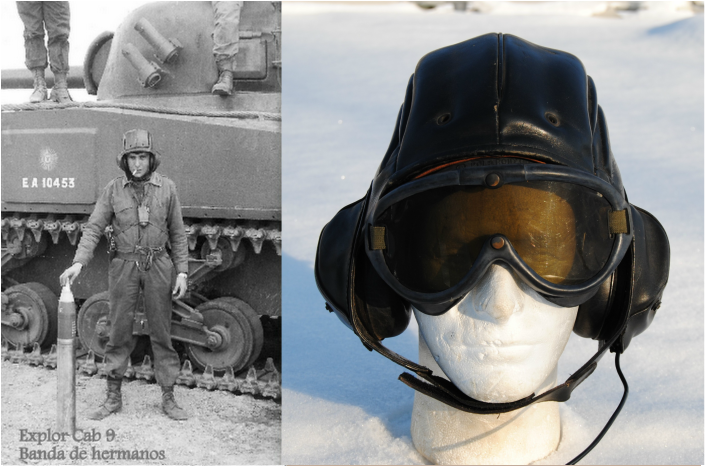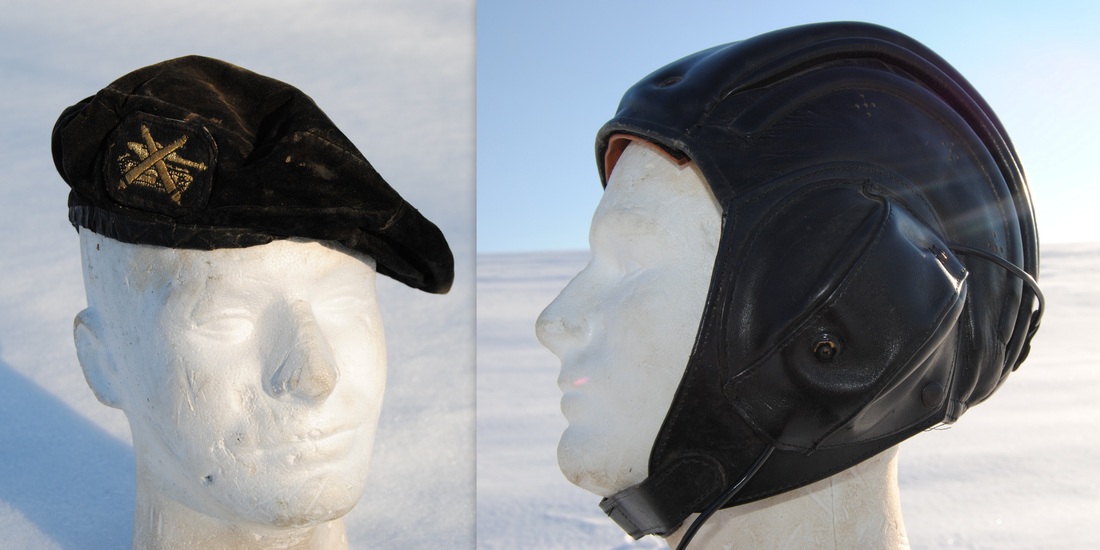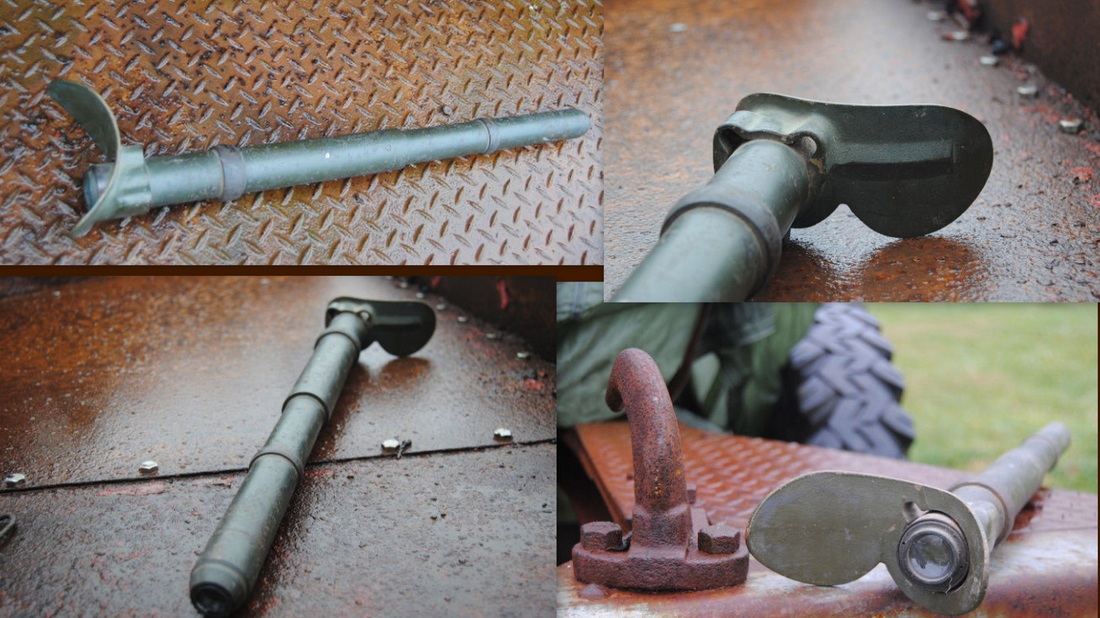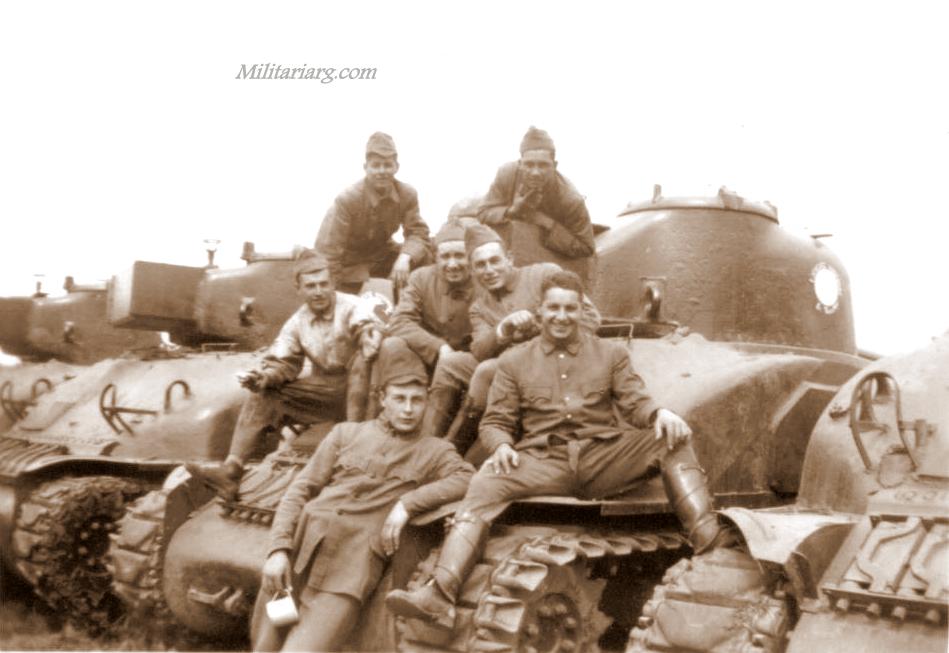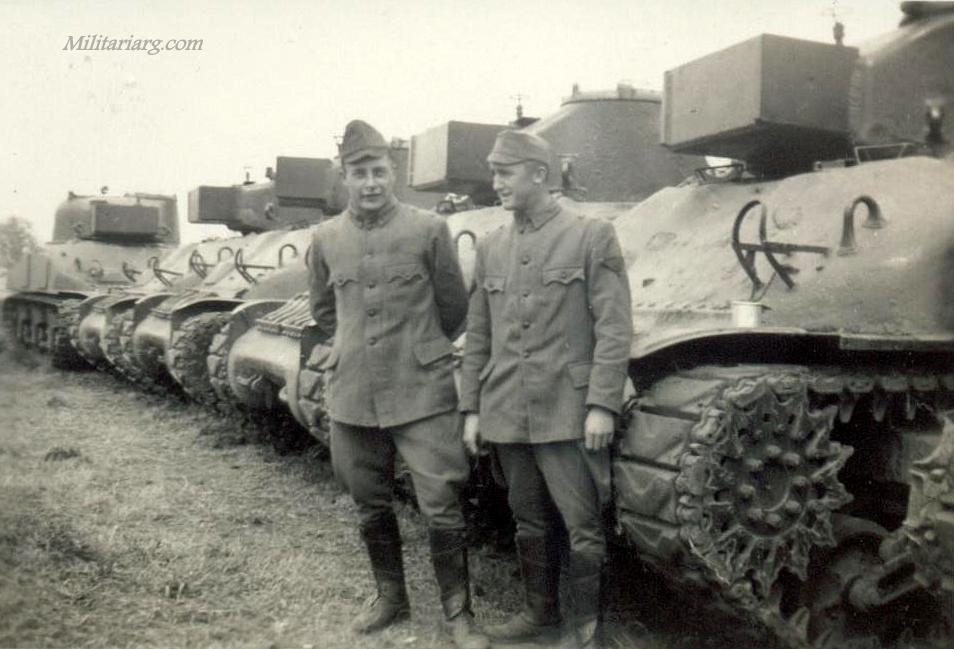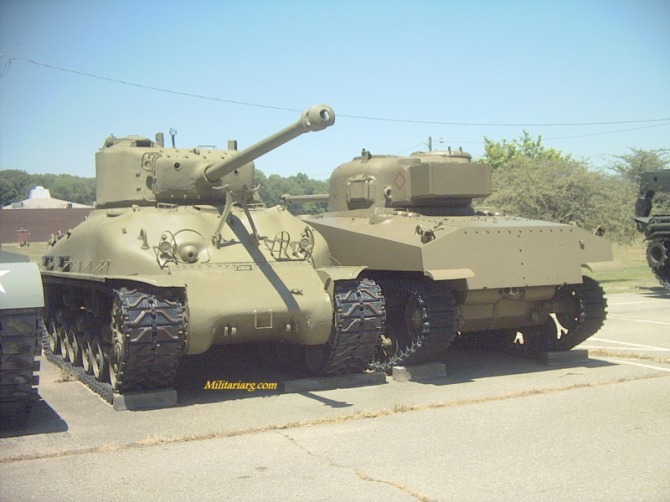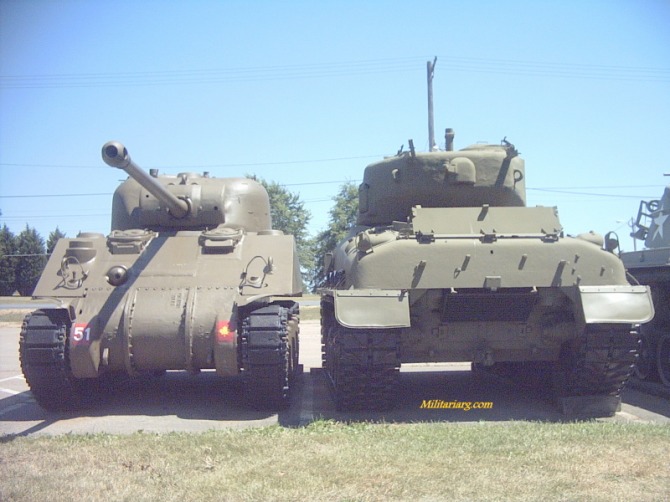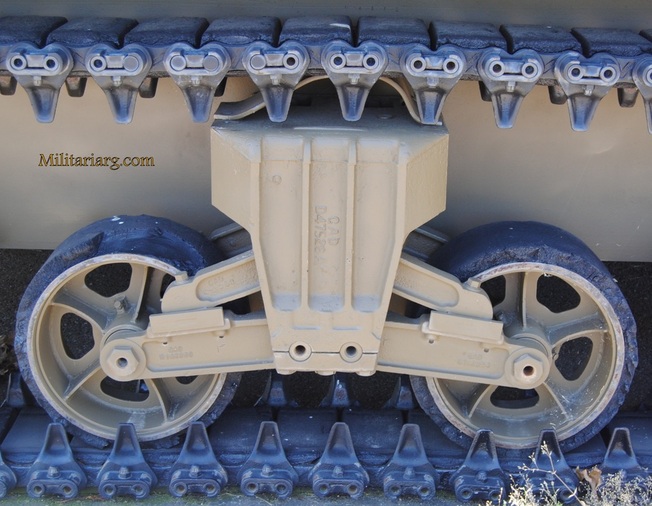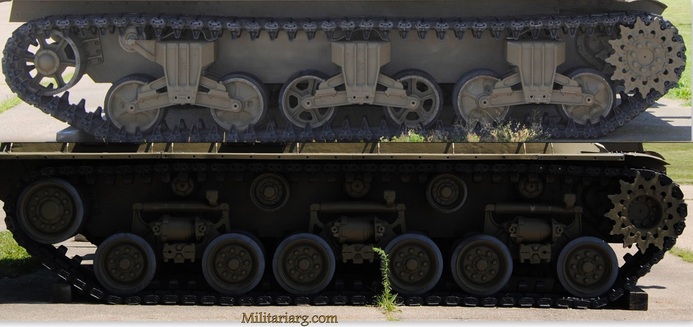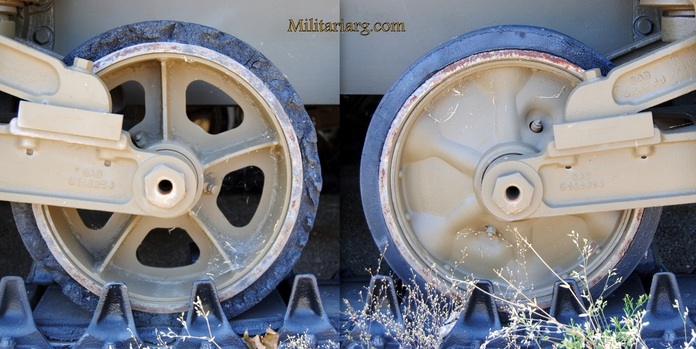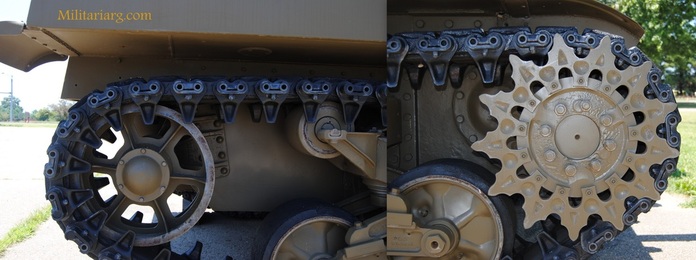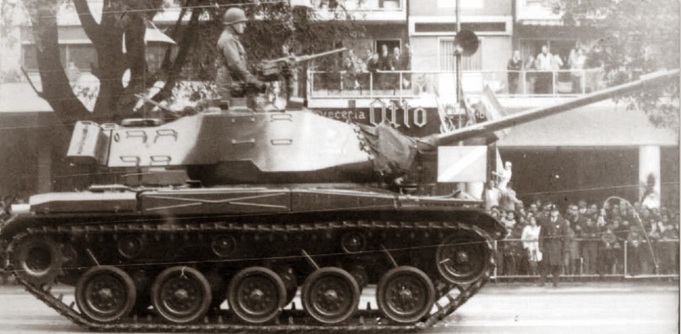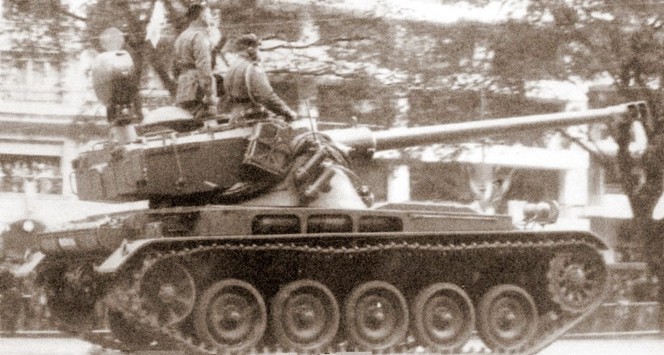FN M86 1936 Armored Motorcycle w/ Vickers Machine Gun.
Tank Vickers : the photo say : " Regimiento 2 de infanteria seccion communicaciones" 1943. Collection FP France. Courtesy of Historian Frédéric Pineau.
Vickers 1934 (M38 Arg). Note the Horstmann Suspension System.
Above are the Vickers light tanks model 1934, M38 Arg . The photo is declassified from the Associated Press. The light armored Vickers incorporated in the decade of the 30s were dependent on the Comando de Arsenales. The crews of these vehicles used the reglamentary combat uniform, including the German type M36 parade helmet and pith helmet. Towards 1940 leather clothing appeared in the mountain troop style for motorized drivers.
Caras y Caretas 1938-39
A little known event is when, for the holiday of the 25th of May in 1924, an Italian tank "Carro armato" paraded. It was a Fiat 3000 M21 (4-cyl Fiat engine). This light tank was an Italian version of the Renault FT-17 armed with a 1x 37mm or 2x 6.5mm Fiat or SIA machine guns. This armored fighting vehicle (AVF) was already surpassed at the moment it came out of production and had a very short career in service. It was replaced by new generations of armored vehicles developed by the Ansaldo Armament of Genoa like the "Carro Veloce" CV.33 or L3/33 which, along with the CV.35 or L3/35, were nicknamed "scatole di sardine" or sardine cans.
There is no data to indicate if this tank arrived in Argentina as part of a marketing campaign to sell it or only to participate in the parade for Memorial Day. Not long after this (1930) Argentina purchased the British Vickers so there may have been an interest in buying tanks beforehand and Italy was showing off its merchandise. Millions of Italian citizens were consantly arriving in the Argentine Republic as immigrants in those days. The tank was seen with the flag of the Regio Esercito Italiano with the shield of Savoy on one side and an Argentine flag on the other. The tank was painted in the camo colors that the British described in the desert as spinach and sand.
There is no data to indicate if this tank arrived in Argentina as part of a marketing campaign to sell it or only to participate in the parade for Memorial Day. Not long after this (1930) Argentina purchased the British Vickers so there may have been an interest in buying tanks beforehand and Italy was showing off its merchandise. Millions of Italian citizens were consantly arriving in the Argentine Republic as immigrants in those days. The tank was seen with the flag of the Regio Esercito Italiano with the shield of Savoy on one side and an Argentine flag on the other. The tank was painted in the camo colors that the British described in the desert as spinach and sand.
May 25, 1924 parade. The picture is from the site argentina.oob.com.ar
The above photo is from probertencyclodeia.com.
This tank was used in counter-insurgency actions against the rebel tribes in Libya and in the service of the AOI (Africa Orientale Italiana). Later it was used in the Slovak-Hungarian War, among other operations.
According to the website Tanks (Armoured Warfare prior to 1946), Argentina was with Czechoslovakia in advanced conversations to incorporate CKD (Ceskomoravska Kolben Danek) 38(T) tanks, known as Panzer 38(T), from the TNHP exportation series, but when WWII broke out it halted the deal. This tank became famous in German hands during the war. When it became dated due to new technology, it served for reconnaissance. The chassis was also used as a basis for anti-aircraft guns, a weapons carrier and the Hetzer tank destroyer.
These tanks had a Skoda 37mm cannon (3.7mm KwK 38(T) L/47.8) and two 7.92mm ZB53 (MG 37t) machine guns (the British made a version of this machinegun called the Besa 7.92mm made by the Birmingham Small Arms Company to mount on their tanks and vehicles).
According to the website Tanks (Armoured Warfare prior to 1946), Argentina was with Czechoslovakia in advanced conversations to incorporate CKD (Ceskomoravska Kolben Danek) 38(T) tanks, known as Panzer 38(T), from the TNHP exportation series, but when WWII broke out it halted the deal. This tank became famous in German hands during the war. When it became dated due to new technology, it served for reconnaissance. The chassis was also used as a basis for anti-aircraft guns, a weapons carrier and the Hetzer tank destroyer.
These tanks had a Skoda 37mm cannon (3.7mm KwK 38(T) L/47.8) and two 7.92mm ZB53 (MG 37t) machine guns (the British made a version of this machinegun called the Besa 7.92mm made by the Birmingham Small Arms Company to mount on their tanks and vehicles).
One of the 50 Czechoslovakian tank Panzer 38(t) (Lt Vz.38) model TNHP acquired from Iran. This tank is conserved near a military museum in Tehran. Next to that yo see the unmistakable figure of a Sherman M4-type tank. The above photo is from Panoramio.com.
According to an entry in Wikipedia they had a 4 member crew. "The two man turret was centrally located and housed the tank's main armament, a 37mm Skoda A7 gun with 90 rounds stored onboard. It was equipped with 7.92 mm machine gun to the right of the main ordnance. This turret machinegun was in a separate ball mount rather than a fixed coaxial mount." Iran was the first importer of the TNHP series while Peru acquired the LTP series. The LTH series was exported to Switzerland and a few LTL to Lithuania.
DL 43 Nahuel (Tiger)
The Nahuel (Tiger), was designed as an infantry support tank. Computarized image of the chassis. Note the Bogie with Vertical Volute Spring Suspension (VVSS) and overhead roller as the M3 Lee, M7 Priest.
Early VVSS M3 Lee/Grant type bogies with overhead roller guide. This suspension system was also found on the early M4 Sherman Tanks.
Left: Colonel Peron, (Minister of War). Center: Lieutnant Colonel Alfredo Aquiles Baisi. Right: Counter Admiral Alberto Tessaire. Many thanks to Georg Rauch for sharing his knowledge with us!
Photos from a parade on July 9, 1944 celebrating the 128th anniversary of the country's independence. Several units from different regions of the country participated. Novelties that awoke a great interest were the Nahuel tank, parachutists, skiers, cyclists, planes, Andinean troops and the mechanized troops. The 2 photos above show the profile of the famous Argentine tank DL43 Nahuel (Puma in the local indiginous language). The tank had a picture of a puma on each side of the body. The Nahuel was a completely Argentine design. Unfortunately there are no tanks left. Originally the radio equipment could have been a local copy of the Telefunken, possibily a TRD or a 5W with a Type A receptor. Later it could have been exchanged for a WS-19 Wireless Set to strengthen it.
Lieut. Colonel Baisi (designer of the Nahuel) in the commander position. The Nahuel 121 series had 3 machine guns in the front and 1 in the tower.
DL 43 Nahuel (DL = Diente de Leon, "Lion's Tooth",
DL43 Nahuel. Armamant: Krupp Model 1909 75/30 mm. 1 x 13mm coaxial MG and three 8mm MG. Like the M4, the 'Nahuel' was armed with a 75mm main gun, and there was a co-axially mounted 12.7mm, and
three hull-mounted 7,65mm machine guns.
Engine: FMA-Lorraine Dietrich 12 EB, 12 cylinders in W, 500 Hp, water cooled. Weight: 35,000 Kg. Crew: 5
three hull-mounted 7,65mm machine guns.
Engine: FMA-Lorraine Dietrich 12 EB, 12 cylinders in W, 500 Hp, water cooled. Weight: 35,000 Kg. Crew: 5
M4 A2 Sherman. Engine: Continental R975 C1, air-cooled, Radial, gasoline.
Crusader SP Tractor Gun. (Post-war modification) . V-12-cyl.340-bhp rear mounted engine (Nuffield Liberty). Armament: Krupp 75mm l.30 mod. 1909 and Bofors 75mm L40 Mod. 1935 field gun. plus three Madsen Mod. 1926 light machine guns 7,65 mm Mauser.
Crusader W/ 75mm Bofors
Argentine Army 1946-47. Crusader Rocket Launcher.
Above are Model T16 armored personal Carriers (Madsen Gun Carriers), in a parade. These vehicles were built by Ford in the US with the Ford Mercury 239ci engine and some modifications plus an extra wheel in the rear for better load and land stability. These vehicles were known as Bren Gun Carriers because of the Bren machine guns that British transported on them. In the Argentine case, their version of the English example could be referred to as the "Madsen Gun Carrier". The driver's position is on the right with a gunner on the left. The transmission, engine and rear axle came from other wheeled vehicles which led to a wear down of the parts. The rear bogie had 2 wheels on each side for extra stability (the Universal only had 1 wheel on each side of the rear bogie). The T16 did not have the stepped rear hull like other carriers. Compared side by side, the T16 Universal Carrier and the Universal Carrier Mark I are 2 very distinct machines, although they were both made by Ford. The T16 had very limited use in the US.
Source: Military Vehicles Magazine
Source: Military Vehicles Magazine
These old trucks had hard, rubber-covered metal tires. On the right is an interesting advertisement for these tires by Goodrich (sold by Henry W. Peabody and Cia at Cangallo 1660 Buenos Aires, Argentina).
Crossley Armored Car Model 1926
Photo: Caras y Caretas 1930.
Caras y Caretas 1930.
Above are M9 Half-Track Personnel Carriers during a parade circa 1950.
British-Sherman IC Hybrid, M9 halftruck, Sherman Firefly, T-16 carrier and Willys.
Sherman Firefly Mk Ic. This photo is from 1950 showing a parade celebrating August 17, the Day of San Martin. Photo publication from the time.
British Medium Tank M3 Grant.
The Medium Tank M3 was an American tank used during World War II. In Britain the tank was called "General Lee", named after General Robert E. Lee, and its modified version built to British specification, with a new turret, was called "General Grant", named after General Ulysses S. Grant.
The Medium Tank M3 was an American tank used during World War II. In Britain the tank was called "General Lee", named after General Robert E. Lee, and its modified version built to British specification, with a new turret, was called "General Grant", named after General Ulysses S. Grant.
US M9 halftrack.
M16 Half-track (M3 base Multiple Gun Motor Carriage equipped with Maxon Mount with M2HB machine guns. Ordnance Museum Abeerdeen.
Images of the now-extinct Motorized Regiment " Motorizados Buenos Aires" from a soldier's 1954 yearbook.
Field kitchen Kärcher
Motorized BsAs from 1940s
10th Armored Cavalry Regiment (Pueyrredon Hussars). 1965.
Crew of a Firefly Mk Vc in front of their tank, waiting to begin practice.
Tankers during a parade celebrating the pledge of allegiance.
The tank crew's uniform in this picture is a simple overall in olive green, like the US Army HBT mechanic overall (Third Pattern), with combat boots (borcegui). The Argentine Tanker Helmet is inspired by the French model from the 1950s that was inspired by the American tanker helmets from WII. It was a semi-spherical, hard aluminum piece, perforated with holes on the surface, covered with rubber. It had a leather sling strap for their 1911 holsters.
1962 Azules vs Colorados.
Mechanized Infantry of the 10th Armored cavalry "Hussars of Pueyrredon".
The 10th Armored Cavalry Regiment, consisting of a tank company and 2 mechanized infantry rifles (Tiradores blindados). Photos from a regiment soldier's yearbook in 1965.
8th Cavalry Horse Rifles Regiment "Cazadores General Necochea" and 10th Armored Cavalry, Hussars "Husares of Pueyrredon".
Historic uniform for Hussar of the 8th Tanks Regiment (Magdalena). The soldier is dressed in a typical dolman jacket and colback shako. The boots are a Hungarian style.
Mechanized soldier poses in front of an M4 A4 Sherman with 75mm M3 L/40 gun.
Tanker Helmets. semi-spherical patterns:
Vickers Carden Loyd Tankette Mod. 1934. Argentine Model 1938. Armament 7,65mm (Argentine Customized). The helmets and uniforms for this vehicle, were the standard uniform for all branches and included the fiber M36 helmet, German shape. The picture is not good quality, but in this picture the tankist locks like it has a semi-spheric helmet.
In this photo you can see clearly that the rider has a spherical helmet. It also appears to have glasses, although they cannot be seen as well. In the rear of the photo are Nahuel tanks.
Interesting photo where you can see a tank helmet First Pattern, from a DL 43 Nahuel crew. It appears to have headphones (telefunken Panzer type?) and devices. This helmet is very similar in form to a parachutist helmet.
Argentine Tankers (Second pattern), helmet from the 1950s. This piece is in the Military Museum (Museo de Armas de la Nacion). Photo from Mariano Gonzalez Lacroix.
Foreign Patterns:
Argentine leather helmet, original or copy (?) of the Telemit, Belgian tank helmet made by VanDePutte, 1970s. for the Sherman Upgrade with 105mm L44 DGFM Gun during the Beagle Conflict in 1978. These upgraded Tanks were equipped with Dutch Philips VHF transceiver. French technicians worked on the upgrades. Photos: ExpCab9
General Belgrano Mechanized Infantry Regiment No. 3 (RIM 3).
1942 Tank Telescope-periscope. This type of telescope (M51 and M70) could be used in the Sherman tanks, among others, in addition to being for land artillery and naval gunner cannons.
US M4A1E8 76mm Sherman next to an Canadian Firefly.
Canadian Firefly vc and US M4 Sherman. (US Army Ordnance Museum)
Above is the Sherman suspension system (bogy), Vertical Volute Spring System (VVSS). This example does not have the "offset roller" This is the most common type on Sherman tanks. The wheels are the early type and measure approximately 17 inches. They are covered with rubber.
Above: Vertical Volute Spring System (VVSS).
Below: Horizontall Volute Spring System (HVSS).
Below: Horizontall Volute Spring System (HVSS).
Two different types of wheels on the same tank. On the left is the older model, the right is the newer one. The early wheel is very similar to that of the Nahuel.
Right: Front Track wheel. Left: Rear Tensioner Wheel. Note the off-set roller guide above the roadwheel.
Torsion bar spring suspension of the M41 "Walker-Bulldog" and M42 "Duster" models.
M41 “Walker Bulldog” Light Tank circa 1966. In 1963 through the Military Assistance Program (MAP) talks began to receive tanks from the US. Argentina was only able to acquire 5 tanks due to the coup in 1966. Some feel that it was actually a good thing because Argentina was forced to make its own tanks, Tanque Aregentino Mediano (TAM). Another heavy tank, an M60 Patton a first-generation main battle tank (MBT) came to Argentina for testing but was not selected due to its weight on the soft Argentine soil..
AMX-13 circa 1970. French tank from the Plan Europa. The also received SK-105 "SK-105 Kürassier", which is the Austrian version of the same tank. The Kurassier was used in serivce in Patagonia.
M113 APC (armored personnel carrier).
SK-105 Kürassier. Photo "La Semana", April.29, 1982.
4x4 Mercedes Benz 230G and field kitchen trailer.
Argentine AML 90 Panhard now in Portsmouth Hampshire, Naval shipyard UK. This is an English naval postcard. The armored vehicle was apparently abandoned by the Argentines then taken to England after the war.
T.A.M "Tanque Argentino Mediano" TAMSE:
The Tanque Argentino Mediano ("Argentine Medium Tank"), or TAM. The vehicle was developed by a German (Thyssen-Henschel) and Argentine team of engineers (T.A.M.S.E), and was based on the chassis of the German Marder infantry fighting vehicle.
